Introduction
COVID‑19 has caused a global recession and Canada and Ontario have not been immune. Every negative economic statistic represents a family that is struggling, a person who has lost their job, or an anxious small business owner facing unprecedented uncertainty.
As Ontario deals with a second wave of COVID‑19, the focus must be on protecting people and providing urgent support to those who need it to make it through these challenging times. However, now is also the time to begin laying the foundation for a recovery fuelled by long-term economic growth. In this Budget, the government is investing $4.8 billion in new funding to do just that.
People in Ontario understand that the economic recovery from COVID‑19 will be a lengthy journey. While no economic downturn is the same as the last, it took between 24 and 88 months to return to pre-recession peak employment across the last three recessions.
To support the recovery of Ontario’s economy the government is acting now to address six critical needs that will have immediate benefits and, left unaddressed, would hold the province back from a stronger recovery:
- Making electricity more affordable;
- Reducing taxes on jobs;
- Connecting workers and employers with the skills and training they need;
- Reducing unnecessary red tape;
- Ensuring sectors can preserve and gain jobs; and
- Building infrastructure.
Just as the Ontario Spirit has helped the province through the depths of the pandemic and brought out the best in people from every region, it will also ensure Ontario is the best place in the world to work and raise a family post-COVID‑19. Ultimately, it will be people, not governments, that drive the province’s recovery. It will be the innovative young entrepreneur that develops the next great technology in Kanata. The family that starts a small business in Brampton. The team of skilled workers in Sault Ste. Marie that build homes and opportunity. The farmer in Essex using Ontario-built equipment. The retired couple in Etobicoke who choose Ontario Made products at the store.
It is the Ontario government’s job to help create the conditions necessary for growth — and sometimes that means getting out of the way. For example, employers choose to locate somewhere other than Ontario because of the province’s high and rising electricity prices for industrial and commercial users. The government is acting to address these jobs killing electricity rates once and for all.
Ontario’s competitiveness problem does not end with electricity prices — taxes are another major expense for job creators. This is why the government is acting to reduce taxes for employers so that their resources can be reinvested in hiring more people with the right skills, expanding their operations across Ontario, and innovating for long-term growth and prosperity.
As COVID‑19 has made clear, digital infrastructure is one of the most critical conditions for growth in 2020 and beyond. Unfortunately, too many parts of the province do not have basic broadband and cellular coverage. To connect people in communities across the province, the government will initiate the next phase of Ontario’s Broadband and Cellular Action Plan: Up to Speed, which brings the government’s total investment in connecting communities digitally to $1 billion.
And, just as the world has changed, government must change with it. The Province is committed to make government services simpler, easier to use, and more convenient and accessible during the COVID‑19 pandemic and beyond — improving the way people and businesses interact with government while saving both time and money.
The conditions required to support economic growth following COVID‑19 are diverse. What they have in common is that they are focused on long-term, structural solutions to problems that have held Ontario back from its full potential. These government actions will help, but it’s the ingenuity and determination of the people of Ontario that will make the province the best place it can be.
A Comprehensive Plan to Reduce Job-Killing Electricity Prices
More Competitive Electricity Prices for Growth and Job Creation
Time and time again, employers considering Ontario as a place to expand or do business have decided to invest elsewhere, in part due to the province’s high commercial and industrial electricity prices. In the 2020 Budget, the government is outlining a plan to reduce the burden on employers of high‑cost contracts with non-hydro renewable energy producers, which will be wound down once and for all.
One of the key competitive negatives for manufacturing in Canada is the high Ontario cost of electricity … these are costs that our American factories don’t face.
Scott Bell
President and Managing Director
General Motors Canada
These high-cost contracts were entered into by the previous government for energy that Ontario does not need at a price that employers cannot afford. In 2009, the previous government introduced the Green Energy Act, which led to high-priced contracts for electricity derived from wind, solar and bioenergy. By signing thousands of these high-priced 20-year contracts with renewable energy producers, the previous government set Ontario on a path of higher prices and lost jobs, culminating in the need for this government to act.
Since 2008, the year before the Green Energy Act was established, the total cost of Ontario’s electricity system, including for the generation and delivery of power to consumers, has increased significantly. For instance, system costs have jumped from $14.5 billion in 2008 to $21.9 billion in 2019, an increase much higher than the rate of growth in overall consumer prices. Approximately 18 per cent of electricity system costs in 2019 came from high-cost contracts entered under the previous government for wind, solar and bioenergy. However, they only provide about eight per cent of the electricity generation supply.
Electricity prices in Ontario rose as a result. As demonstrated in Chart 1.6, the price of electricity for industrial employers increased by 37 per cent from 2008 to 2019, while commercial employers have seen their electricity commodity costs increase by about 118 per cent over the same time period. These increases far outpaced the overall rate of consumer price inflation (21.4 per cent) over the same period. That means the increase for commercial employers was about five times higher than the rate of inflation.

The rising cost of electricity has made Ontario a less attractive place to do business. As a result, the people of Ontario have missed out on jobs and opportunities as employers in industries like mining, steel and manufacturing pass over the province in search of a more competitive business environment.
Although this was an issue before COVID‑19, the pandemic has made fixing this problem an urgent priority that must be addressed if Ontario is going to compete successfully to attract new investments, as governments around the world plan for a recovery from the global recession.
Reducing Job-Killing Electricity Prices

Starting on January 1, 2021, a portion estimated at approximately 85 per cent of these high‑cost wind, solar and bioenergy contracts, entered into under the previous government, will be funded by the Province, not ratepayers. Removing these costs from electricity bills will result in medium size and larger industrial and commercial employers saving about 14 and 16 per cent respectively, on average, on their electricity bills. This new policy will provide lower and more stable prices for Ontario’s electricity supply.
As shown in Charts 1.7 and 1.8, an illustrative example of industrial (Class A) and commercial (Class B) consumers, such as an automotive parts manufacturer and a small hotel, would receive about $382,000 and $130,000 respectively in annual savings. Those savings will not only make Ontario more competitive but can be reinvested by businesses to hire more employees, expand operations and grow the economy.
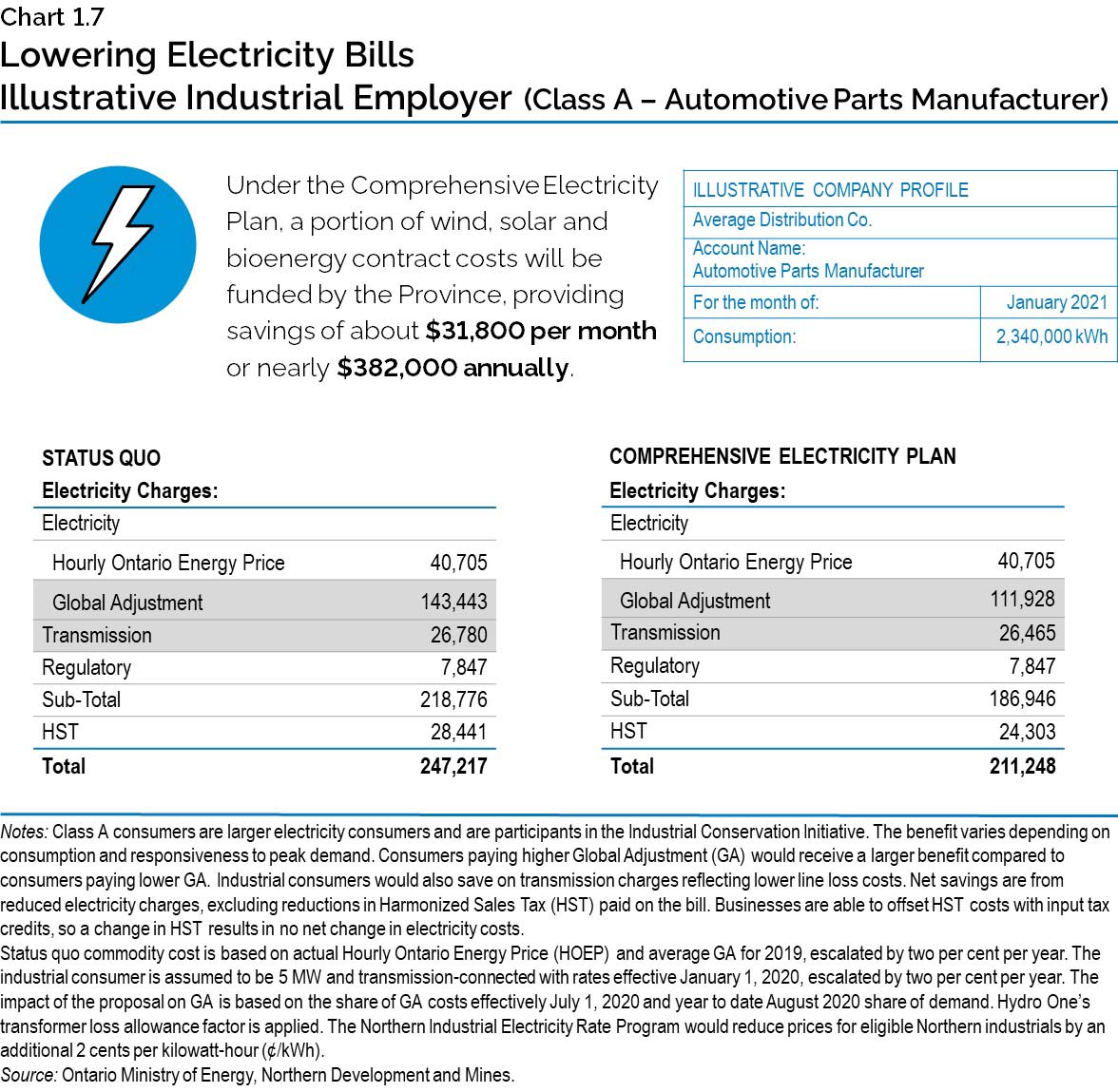
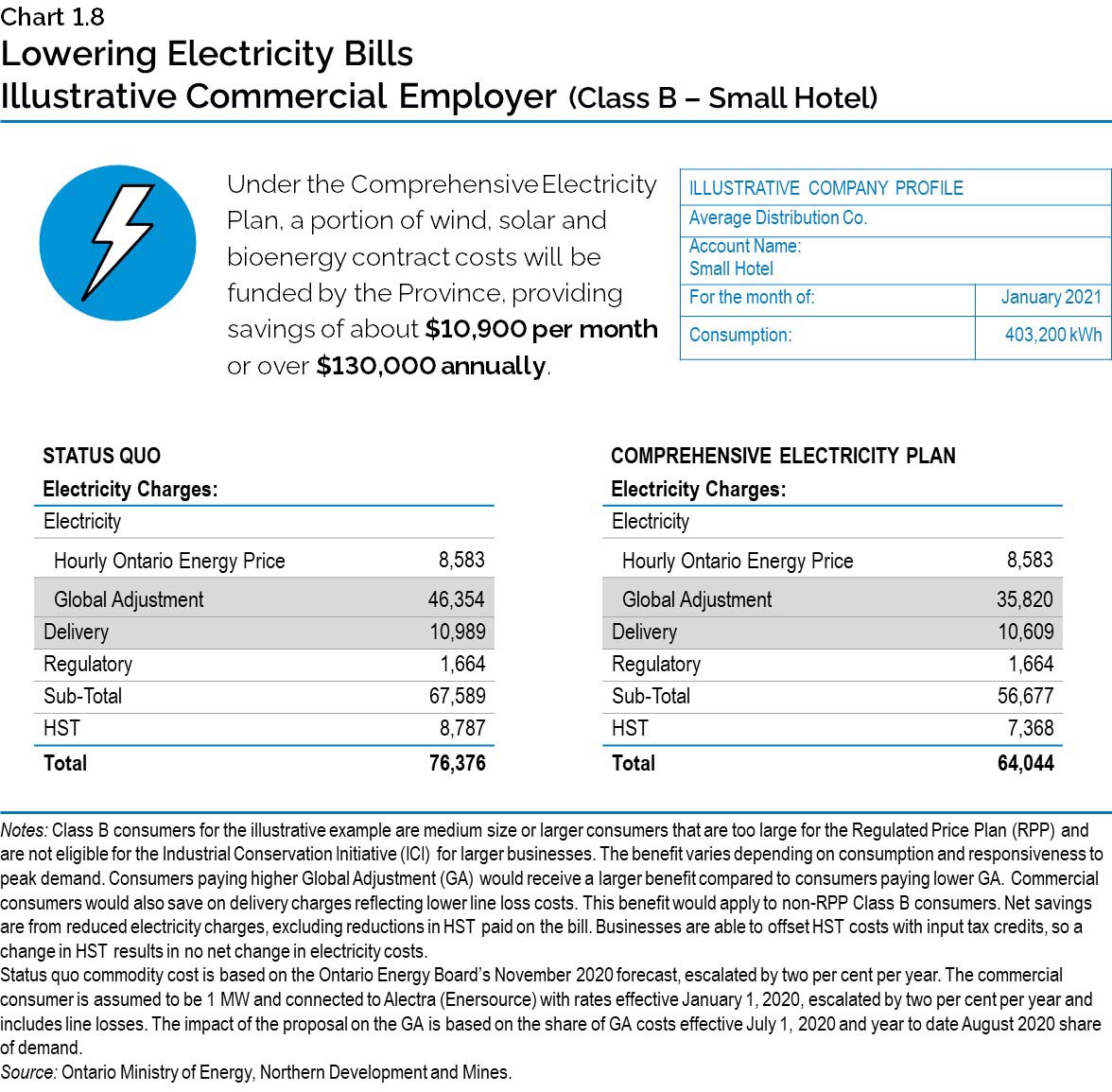
Because most of the contracts entered into by the previous government will be in place over most of the next decade, the government’s action will provide significant, multi-year relief to employers and more certainty on electricity costs as they plan for their future investments, helping to create jobs in Ontario.
In addition, because Ontario’s supply of electricity has large fixed costs, when demand is low or declines, this typically results in higher prices for commercial and industrial employers. By making Ontario’s electricity prices more competitive, there is an opportunity to grow electricity demand by attracting investments from energy intensive businesses that have avoided Ontario due to higher costs. Increasing industrial and commercial electricity consumption can help spread the fixed system costs over more users, which can help reduce the average price for other commercial and industrial employers.
Making Ontario Competitive
Reducing Ontario’s electricity prices for industrial and commercial employers to an estimated 8.05 and 14.31 cents per kilowatt-hour (₵/kWh), on average, respectively, will reduce average prices to below the average in the United States. This has significant implications for employers that are choosing between Ontario and the United States to expand or set up shop.
Based on U.S. studies on the economic impact of changing electricity prices on manufacturing employment,2 it is estimated that the reduction in the average price of electricity for industrial users in Ontario would, over time, result in the creation or retention of up to 29,000 jobs in the manufacturing sector alone.

This initiative is in addition to the benefits of other programs that are being maintained to provide electricity cost relief to eligible companies, such as the Northern Industrial Electricity Rate program and the Industrial Conservation Initiative (the latter program is also designed to provide electricity system benefits). Taken together, these measures provide greater stability and cost predictability for Ontario’s employers, supporting economic activity and job creation, while the Ontario Electricity Rebate continues to protect households, farms and small businesses, including main street restaurants and retail shops, as Ontario emerges from COVID‑19 and continues down the path to economic recovery.
A Plan to Responsibly Wind Down High-Cost Contracts
Under previous governments, the electricity system became increasingly burdened with high costs, including high‐priced long‐term contracts for electricity that Ontario did not need and at prices consumers could not afford.
The government is committed to fixing the previous government’s mess. While the Province is making a significant investment to provide long-term electricity cost relief to help Ontario’s job creators, the fiscal impact of directly funding a portion of the costs of these contracts for wind, solar and bioenergy is expected to decline year over year, as the cost of the 20-year contracts signed starting in the mid-2000s begins to decline as these contracts expire. By about 2040, no further provincial funding would be required to subsidize the cost of these contracts. The government has already taken action to reduce system costs and will continue to do so as these contracts are wound down.
It took a generation to create this problem. Unfortunately, it will take a generation to fix it. The plan starts now.
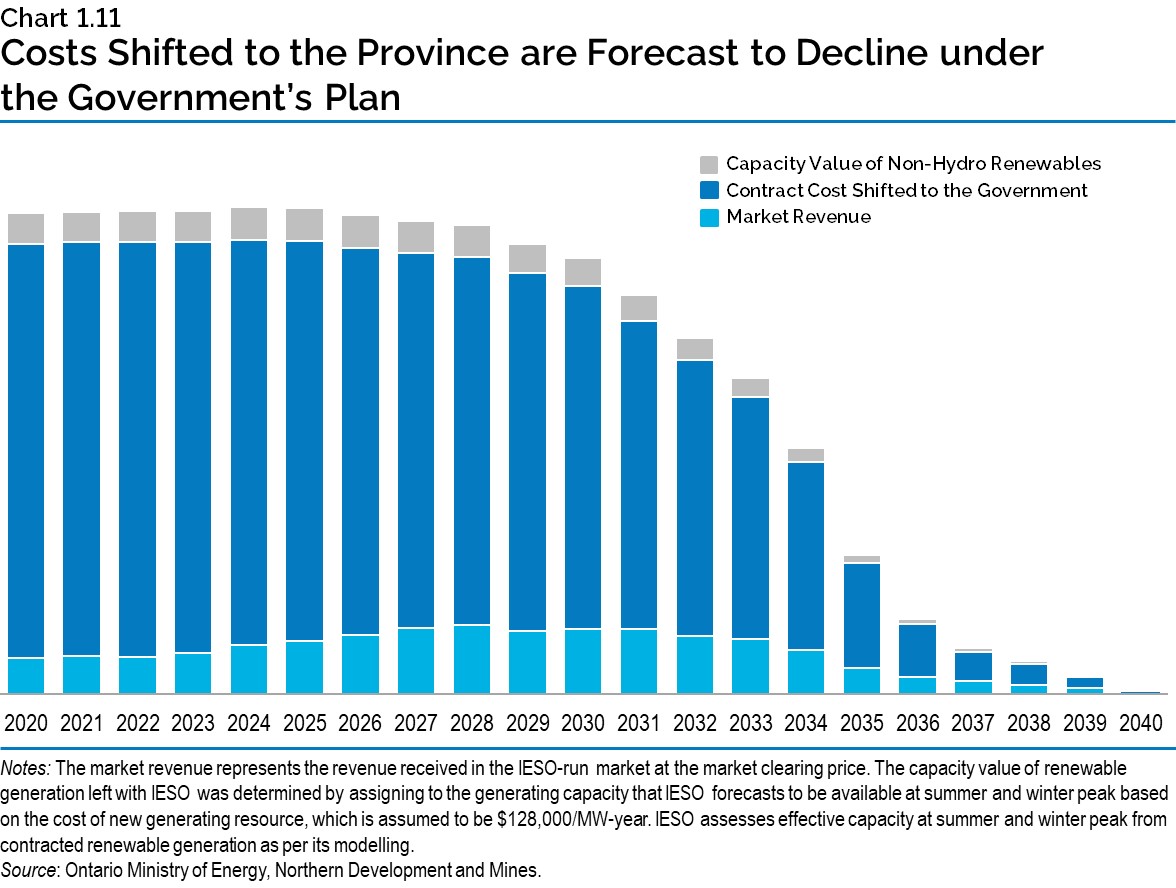
Reducing Taxes on Jobs
Reducing Property Taxes for Job Creators
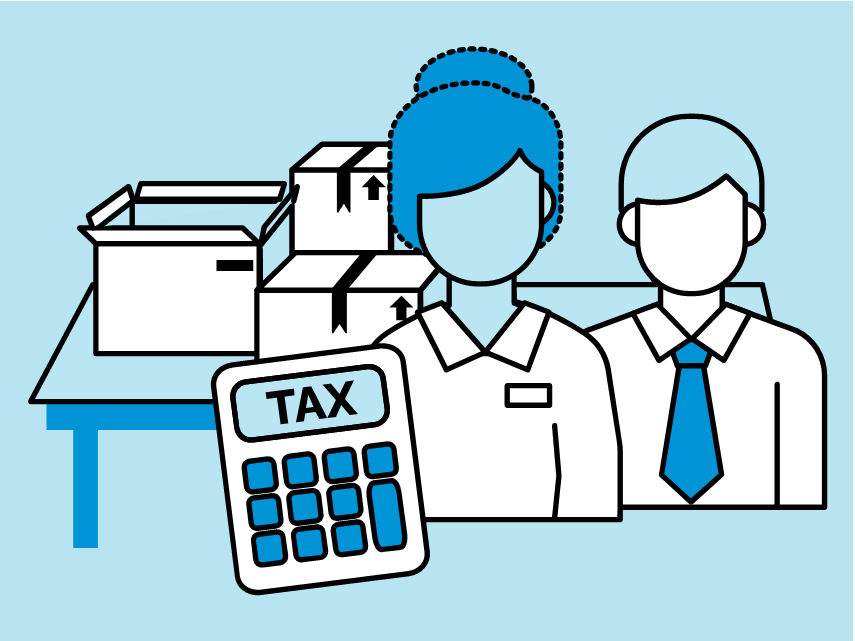
Among the many financial challenges caused by COVID‑19, businesses continue to bear fixed costs even while serving fewer customers — either because of public health restrictions or because it takes time for people to feel confident re-engaging with the economy. These costs are expenses that continue despite a business not operating at all or operating at lower than normal capacity and are effectively job‑killing taxes.
We believe… that current provincial tax policy with respect to setting business education property tax rates is a significant factor that is negatively affecting economic development and conditions in London and the surrounding region.
Ed Holder
Mayor, City of London
Property taxes are one of the most unavoidable costs businesses face. In Ontario, there is currently a wide range of Business Education Tax (BET) rates across the province. This creates an unfair challenge for businesses operating in communities with higher rates, impacting their competitiveness.
Ontario has heard loud and clear from municipalities and employers that, as the province recovers from COVID‑19, addressing this variation in BET rates would reduce regional tax unfairness and make the entire province more competitive. As a result, Ontario is acting immediately to reduce high BET rates by $450 million in 2021. This provides relief now and in the future.
This tax reduction will reduce all high BET rates to a rate of 0.88 per cent. This represents a reduction of 30 per cent for the many businesses that are currently subject to the highest BET rate in the province. These reductions will benefit over 200,000 business properties, or 94 per cent of all business properties in Ontario.
To ensure this measure does not have a financial impact on school boards, the Province will adjust payments to school boards to offset the reduction in education property taxes.
See Annex: Details of Tax Measures and Other Legislative Initiatives for further information.
Cutting property taxes and the government’s comprehensive electricity plan result in significant savings for businesses that can be reinvested for growth and job creation. Illustrative examples of these savings are shown in charts 1.12 and 1.13.
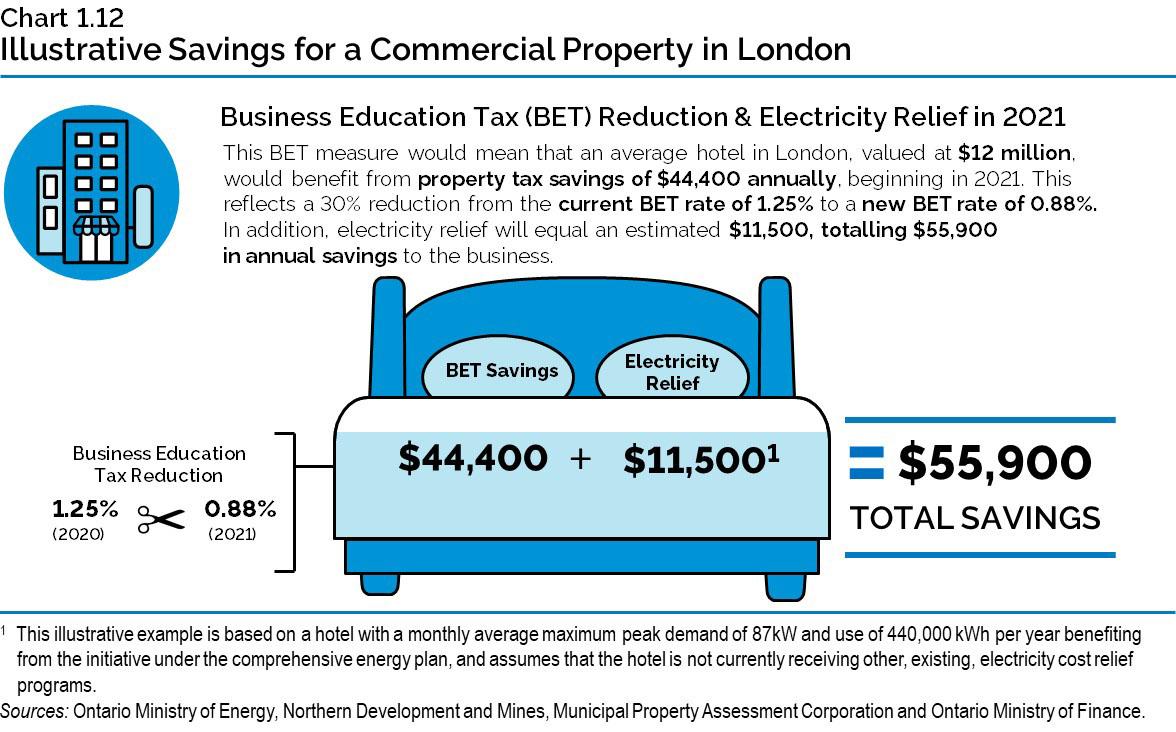
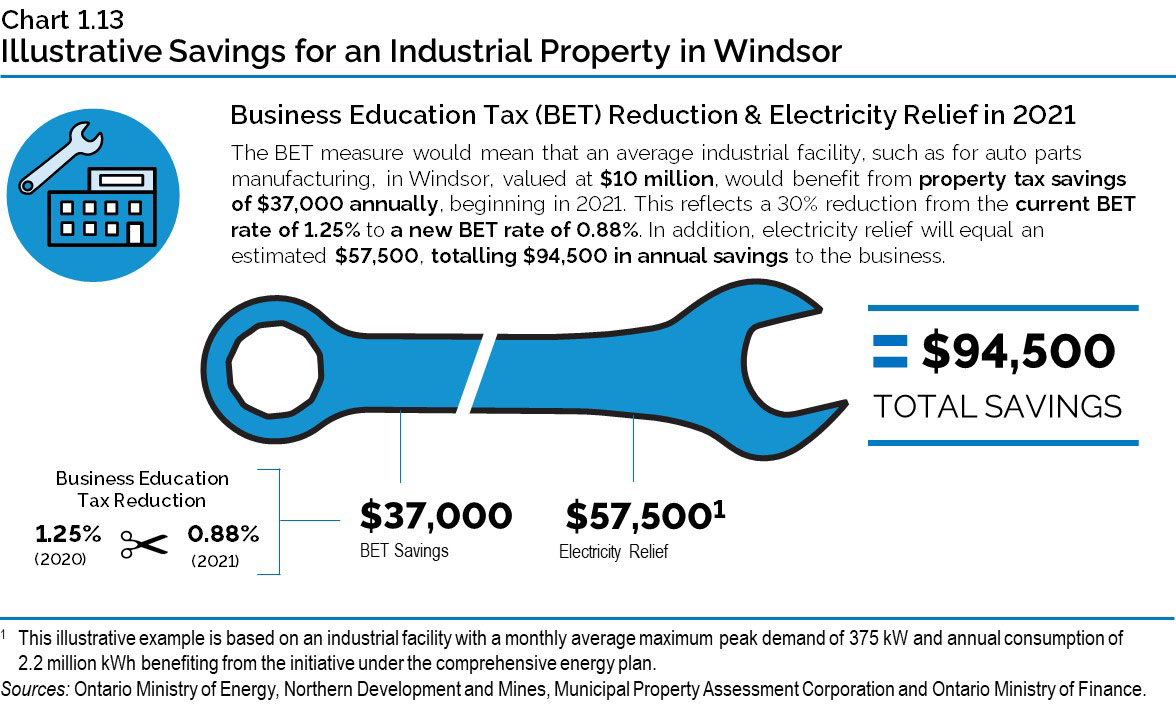
Property Tax Relief for Small Businesses
As employers continue to navigate COVID‑19, some municipalities have asked for additional property tax tools that would provide targeted tax relief to small businesses and increase business competitiveness.
In response, Ontario is acting, so that beginning in 2021, municipalities would be able to provide a property tax reduction for eligible small businesses through the adoption of a new optional small business property subclass. The Province will consider matching these municipal property tax reductions in order to further reduce taxes on jobs now and in the future.
See Annex: Details of Tax Measures and Other Legislative Initiatives for further information.
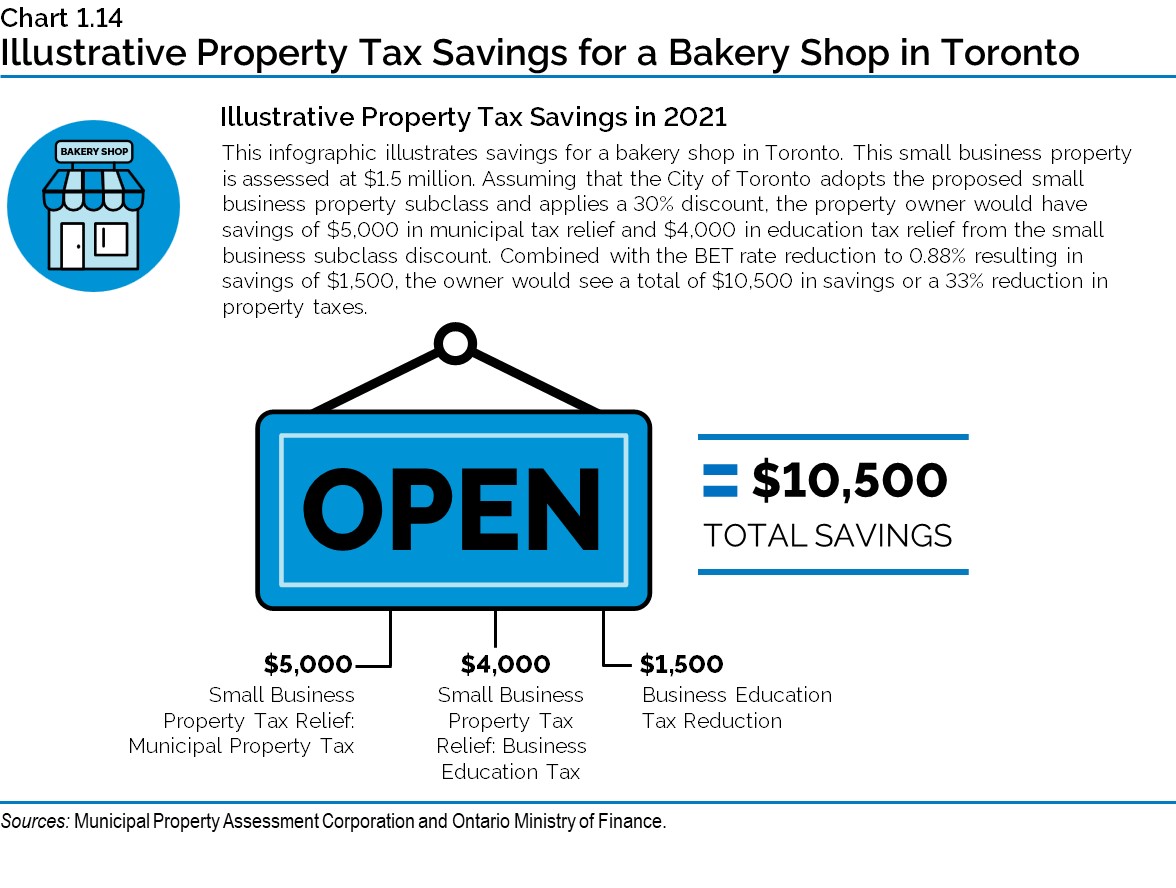
Lowering Payroll Taxes for Private-Sector Employers
The Employer Health Tax (EHT) is a tax on jobs paid by employers on their total Ontario payroll, with a top rate of 1.95 per cent. Eligible private-sector employers receive an exemption, so that they do not pay EHT on a certain portion of their payroll. In 2019, that exemption amount was set at $490,000, meaning that eligible employers did not have to pay EHT on the first $490,000 of their payrolls.
When the COVID‑19 outbreak struck Ontario, the government acted quickly to help private-sector employers with their 2020 payroll taxes by more than doubling the EHT payroll exemption from $490,000 to $1 million. With this additional relief, about 90 per cent of Ontario private-sector employers are exempt from paying EHT this year.
The government is proposing to support private-sector employers further by making this $1 million payroll exemption for EHT permanent, as they weather the current challenges brought on by COVID‑19, while also helping build the foundation for a strong provincial economic recovery.
Starting in 2021, this proposed exemption increase would provide additional annual tax relief (estimated at $360 million in 2021–22). About 57,000 employers would benefit in 2021, of whom 30,000 would no longer pay any EHT. This measure would mean that eligible private-sector employers would save up to a total of $19,500 annually in EHT going forward. However, Ontario’s largest employers (with over $5 million in payroll) will continue to pay EHT.
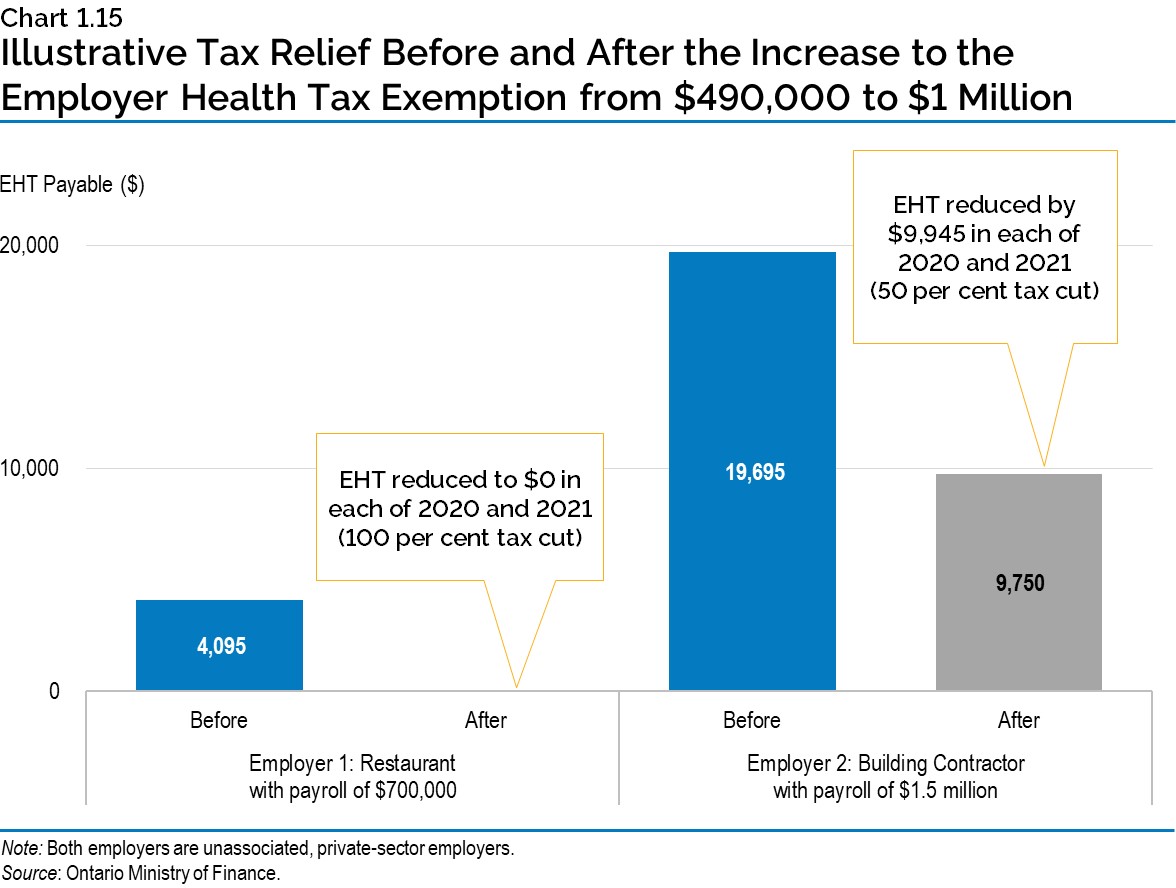
Retraining and Skilled Trades

Many workers in Ontario lost their jobs as a result of the COVID‑19 pandemic. Between February and May 2020, employment declined by 1,156,500, or 15.3 per cent, and the unemployment rate increased from 5.5 per cent to 13.6 per cent. Among those most impacted by the pandemic include workers in sectors such as tourism and hospitality, youth aged 15 to 24, females and workers with lower wages. While there has been a strong recovery in jobs, employment in September remained 318,500 jobs below its pre‑COVID‑19 level and unemployment remained elevated at 9.5 per cent. By connecting workers most impacted by COVID‑19 with the training they need, and helping industries find the skilled workers they need to grow, jobs can be created and Ontario’s recovery can be supported.
To help people retrain and upgrade their skills, the government is investing an additional $180.5 million over three years in micro-credentials, employment services and training programs, including apprenticeships. The Province is taking comprehensive action to help get people back to work and contribute to Ontario’s economic recovery, including a focus on the groups and sectors most impacted by the pandemic.
COVID‑19 Recovery Assistance Skills Plan
The Province is committing $100 million in funding for 2020–21 through Employment Ontario for skills training programs for workers most affected by COVID‑19. This dedicated funding will help more workers and job seekers get advice, training and other assistance they need to upgrade their skills and find good jobs.
Ontario’s Skilled Trades Strategy
The Skilled Trades Strategy will modernize Ontario’s skilled trades and apprenticeship system and help enable the province’s economic recovery by breaking the stigma, simplifying the system and encouraging employer participation.
Three Pillars of Ontario’s Skilled Trades Strategy

Breaking the Stigma
Expanding Pathways:
- Ontario Youth Apprenticeship Program
- Skills Ontario
- Pre-Apprenticeship Training Program
- COVID-19 relief for Pre‑Apprenticeship providers
Education Strategy:
- Youth Advisors
- Specialist High Skills Major

Simplifying the System
Providing Easier Access:
- Skilled Trades Panel
- Tools Grant
- Grant for Apprentice Learning
- Apprentice Development Benefit
- Digital Portal
Training Delivery Agents:
- In-Class Enhancement Fund
- Apprenticeship Capital Grant
- COVID-19 Health and Safety Support

Encouraging Employer Participation
Connecting Business with Talent:
- Skills Development Fund
- Achievement Incentive
- Group Sponsorship Grant
- Training Opportunities through Major Infrastructure Projects
Breaking the Stigma
To help young people and their parents recognize the skilled trades as exciting, fulfilling and well‑paying careers, the Province is working to erase the stigma around blue-collar jobs. Some of the Province’s key initiatives in 2020–21 to attract and train youth in the skilled trades include:
- Investing $17 million to increase awareness of careers in the skilled trades through the Ontario Youth Apprenticeship Program, which works to present high school students with opportunities to learn about work in the trades, and/or train as apprentices while completing their Ontario Secondary School Diploma;
- Boosting funding by $6 million through Skills Ontario to increase awareness of the trades among elementary and secondary school students;
- Investing $21 million in Ontario’s Pre-Apprenticeship Training program, giving students and graduates exposure to a variety of good jobs in the skilled trades. The program is free for participants and includes a work placement;
- Providing an additional $500,000 to pre-apprenticeship training service providers to assist them with implementing COVID‑19 health and safety measures during the pandemic;
- Appointing three Youth Advisors to reduce stigma and make the trades a viable first choice for young people; and
- Investing $42 million in Specialist High Skills Major programs. This program enables students in Grades 11 and 12 to complete sector-specific courses, earn valuable industry certifications and gain important skills on the job through cooperative education placements.
Simplifying the System
To make it easier for people to be part of the skilled trades, the Province is investing an additional $75 million over the next two years, starting in 2020–21 to simplify the system and remove obstacles for apprentices to begin their careers by:
- Appointing a five-member Skilled Trades Panel to provide recommendations on ways to modernize the skilled trades and apprenticeship system, including compliance with compulsory training and certification requirements;
- Investing $2.5 million this year and $7.5 million next year to launch the new non-repayable Tools Grant, which provides between $400 and $1,000 to apprentices to assist with the costs of purchasing trade-specific tools and equipment;
- Investing $5.8 million in the Grant for Apprentice Learning to support those not earning income while attending in-class training, including a boost of $1.3 million this year and next year;
- Investing $24 million in the Apprentice Development Benefit to supplement EI benefits for eligible apprentices attending full-time in-class training, including a boost of $4 million this year and next year;
- Investing $4.7 million in 2021–22 as part of a multi-year commitment towards the development of a new user-friendly digital portal to support the skilled trades and apprenticeship system in Ontario;
- Committing a total of $211.9 million in the In-Class Enhancement Fund in 2020–21 and 2021–22 to support training providers to deliver higher quality training, including a boost of $11.8 million this year and $22.3 million next year;
- Investing an additional $10 million in 2021–22 in the Apprenticeship Capital Grant to help training providers upgrade their facilities with state-of-the-art and modern equipment, for a total investment of $24 million; and
- Investing $5.1 million to assist training delivery agents with implementing COVID‑19 health and safety measures, including purchasing personal protective equipment (PPE), cleaning products and digital supports.
Encouraging Employer Participation
In 2016, nearly one in three journeypersons in Ontario was age 55 years and older.3 To increase employer participation in sponsoring and hiring trained apprentices, the Province is:
- Establishing a new Skills Development Fund, which will provide $30 million, over two years beginning in 2020–21, to support a blend of operational and capital enhancements for non‑college training providers, businesses and associations that train apprentices;
- Investing $21 million in 2020–21 in a new Achievement Incentive Grant to encourage small‑ to medium-sized employers to train apprentices towards program completion and trade certification;
- Supporting business participation by investing $20 million in 2020–21 for a new Group Sponsorship Grant to encourage small- to medium-sized employers to come together to provide a full scope of training and on-the-job mentorship for apprentices; and
- Working with industry on workforce planning for major infrastructure projects to ensure that Ontario is playing a leadership role in efforts to increase apprenticeships.
Together, these changes will ensure that skilled trades in Ontario grow and meet future demands by connecting employers with the talent they need.
Supporting Workers to Acquire In-Demand Skills
The university sector is a key ally in Ontario’s economic recovery. We strongly urge investments in the creation of micro-credentials and particularly those with work-integrated learning.
Jill Scott
Provost and Vice-President, Academic Affairs
University of Ottawa
Micro-credentials provide learners with rapid training opportunities to acquire in-demand skills mostly in the private sector. This includes offering a quick pathway to employment for workers who lost their jobs as a result of the COVID‑19 pandemic. The Province is investing $59.5 million over three years to support Ontario’s first micro-credentials strategy, which will help people retrain and upgrade their skills to find new employment. The funding will help:
- Create an online portal to access micro-credential training opportunities;
- Create a fund to incent the development of new micro-credentials that respond to regional labour market needs and strengthen partnerships between postsecondary institutions, training providers and employers, distributed through a competitive call for proposals;
- Launch a public awareness campaign to promote micro-credentials among learners and employers;
- Expand Ontario Student Assistance Program (OSAP) eligibility to include students enrolled in ministry-approved, quality-assured micro-credentials programs; and
- Work with eCampus Ontario and other partners to develop a virtual passport that issues and tracks a person’s learning experiences to set the foundation for lifelong learning.
Redesigning Second Career
COVID‑19 has had a significant impact on Ontario’s labour market. This is why the government is redesigning the Second Career program to support workers laid off due to COVID‑19 by making it easier for them to retrain and upgrade their skills. The redesign will:
- Prioritize and give faster access to Second Career for laid-off workers from low-skill occupations in sectors most impacted by COVID‑19 in 2020;
- Focus on short-duration training up to 52 weeks, including micro-credentials that lead to in‑demand jobs in order to be more responsive to labour market conditions;
- Help clients to train in occupations that are in demand within local communities and in priority sectors; and
- Begin to digitize the application process in a more user-centred and efficient way.
The redesign consists of two phases with the first phase to begin fall 2020 and would include short term adjustments to strategically refocus the program within the current context of COVID‑19 and economic recovery. The second phase will modernize Second Career and continue to align with other workforce development and training initiatives.
Giving Workers New Pathways to Good Jobs
The Province is investing $37 million in employment and training services to help more than 15,000 people train for new jobs and upgrade their skills to fit the evolving needs of Ontario’s economy. The funding will enable trainees to contribute to the province’s economic recovery. The investment will support 86 projects and provide training in high-demand skills like information technology, advanced manufacturing, truck driving, construction and horticulture. The programs include internships and other hands-on learning experiences.
Enhancing Canada-Ontario Workforce Development Agreements
Labour markets across Canada have been impacted by the pandemic, with significant job losses in all provinces. Ontario will be receiving additional funding for the current and following fiscal year under the Canada-Ontario Workforce Development Agreements. This will ensure workers have access to, and are aware of, the training and employment support they need to re-enter the labour market.
Building Pathways to Careers in Corrections
The government is committed to supporting the economic recovery of the province by hiring officers in Ontario’s correctional system. To support access to these jobs, especially for those hardest affected by the COVID‑19 pandemic, the government will be compensating the new correctional officer recruits while they are undergoing training to remove barriers to employment in Ontario’s correctional system. This will create job opportunities for those who want to pursue a rewarding career in public safety.
Including Women in Ontario’s Economic Recovery
While COVID‑19 has impacted every person across Ontario, female workers have been disproportionally affected.4 Female workers tend to be overrepresented in industries hardest hit by the pandemic, such as accommodation and food services, which saw a 46 per cent employment decline from February to May 2020. As of September 2020, female job losses were 23,000 higher than males.
A successful economic recovery for Ontario must include strong economic participation by women. Ontario is also helping women gain in-demand job skills through initiatives such as expanding micro-credentials that will enable a quick pathway to regaining employment, and the Skilled Trades Strategy. The government is also committing to create up to 30,000 new child care spaces in the next five years, enabling more women with children to participate in the workforce.
By giving every person in Ontario the opportunity to reach their full potential, the province’s recovery will be swifter and more robust, setting Ontario on a path to a strong economic rebound.
Reducing Unnecessary Red Tape

The government has made significant progress to streamline Ontario’s regulatory system. Through the introduction of twice-annual burden reduction and regulatory modernization packages many duplicative or outdated rules that place burdens on businesses, municipalities, universities and colleges, school boards and hospitals have been ended.
As these duplicative and outdated requirements are removed in a careful and meticulous way, the government is committed to ensuring that health, safety and environmental protections are either maintained or improved.
As a result of the government’s progress:
- The total number of regulatory compliance requirements affecting businesses has been reduced by 4.2 per cent between June 29, 2018 and June 30, 2020; and
- A total of $331 million in net annual savings in regulatory compliance costs has been achieved to businesses, not-for-profits, municipalities, universities and colleges, school boards and hospitals since June 29, 2018.
In addition, this past October, the Ontario government introduced the Better for People, Smarter for Business Act, 2020. If passed, the Act will modernize regulations and streamline processes to help stimulate productivity and economic growth. Proposed changes in the Act, along with other measures, include:
- Requiring gas and electric utilities to adopt the Green Button Connect My Data and Download My Data standard to help the people of Ontario understand their energy use and reduce costs;
- Supporting renewable and alternative fuels and emissions reduction technology;
- Allowing single traffic studies for an entire specified highway corridor or area to reduce duplication and enable developers to get shovels in the ground faster;
- Protecting the environment and the health and safety of the people of Ontario by improving hazardous waste tracking;
- Consulting on amendments to clarify when pre-start reviews are required in factories in order to make it easier for businesses to comply;
- Making it easier for property developers to get the environmental information they need by moving from a manual paper-based process to a much faster separate alternative digital delivery platform;
- Requiring water bottling companies to receive support from the host municipality prior to applying for a new or increased permit to take ground water; and
- Helping intercommunity bus carriers fill service gaps and meet local community transit needs.
The proposed Better for People, Smarter for Business Act, 2020 is the latest in a series of red tape reduction and regulatory modernization efforts to make Ontario more competitive, attract investment and create jobs. By modernizing regulations and streamlining processes, the government is creating a supportive environment that will help businesses regain stability and prepare for future opportunities.
Supporting Ontario’s Sectors
Tourism
2021 – Year of the Ontario Staycation

The magnificence of Niagara Falls. The splendor of the North. The awe-inspiring attractions of Ottawa, the capital city of the greatest country on earth. As a tourist, no matter what you are looking for, you’re likely to find it in Ontario.
And that is good news, because regardless of the trajectory of COVID‑19, it is likely that tourism travel within Ontario will be an option sooner than travel beyond our province’s border.
To stay competitive in the most dynamic industry in the world and safeguard the livelihoods of hundreds of thousands of Ontarians the tourism industry needs support to encourage Ontarians to travel within the province.
Beth Potter
President and CEO
Tourism Industry Association of Ontario
The tourism sector is an important part of Ontario’s economy and will need support to recover from the economic impacts of COVID‑19 as the effects of the pandemic diminish.
The government is exploring ways to provide Ontario residents with support of up to 20 per cent for eligible Ontario tourism expenses to encourage them to discover Ontario in 2021 when public health experts advise it is safe to do so. The government is setting aside $150 million for this initiative and will be consulting with stakeholders about the details. An update on this temporary support measure will be announced at a later date.
Supporting Ontario’s Heritage, Sport, Tourism and Culture Industries
Aside from health care, this pandemic hit the tourism industry first, hit us the hardest, and it’s likely to hit us the longest. Recovery remains a long way off for the travel, tourism, hospitality, and cultural industries. While there is still work to be done, we have been pleased to see some programs introduced by the government that we think will help preserve jobs, preserve businesses, and preserve visitor spending.
Michael Crockatt
President and Chief Executive Officer
Ottawa Tourism
When the COVID‑19 outbreak began, Ontario’s heritage, sport, tourism and culture industries were among the most heavily impacted. As a result, tourism‑related industries, which include food services, accommodations, information, culture and recreation saw a total combined decline of 282,100 net jobs between February and May, or a 37 per cent decline in employment. The government is committed to preserving jobs and supporting businesses in these vital sectors.
Tourism Economic Development and Recovery Fund 2020
In August, the government invested $1.5 million through the new Tourism Economic Development Recovery Fund which will support projects that develop innovative tourism products and experiences, drive private-sector tourism investments, bolster workforce development and support tourism operators to learn more through tourism industry associations.
Amending the Travel Industry Act
Regulatory changes were made to the Travel Industry Act, 2002 in the spring to reduce the burden on travel agents and wholesalers impacted by COVID‑19. In addition, the government is providing $4.4 million to the Travel Industry Council of Ontario (TICO) to support its operations and waiving its oversight fee this fiscal year. This financial support allows TICO to provide a one-year fee holiday to approximately 2,300 travel agents and wholesalers registered under the Agency.
Tax Supports for Cultural Industries
COVID‑19 has disrupted production activity in the cultural industries. To support companies during the pandemic, Ontario Creates has provided program flexibility to applicants to provide immediate cash flow and transformed service delivery by adapting to a virtual environment. Production delays may result in some companies being unable to meet current deadlines for the film and television, interactive digital media and book publishing tax credits. To help companies maintain their tax credit eligibility and to help provide some stability and certainty in uncertain times, the Province is proposing to temporarily extend some timelines and amend some requirements for the cultural media tax credits.
The government will continue to work with cultural industry stakeholders, including the Province’s Film and Television Advisory Panel, to discuss ways to grow high-value cultural industry production in Ontario.
See Annex: Details of Tax Measures and Other Legislative Initiatives for further information.
Modernizing Ontario’s Financial Services Sector
Modernizing the Credit Union Sector
The Credit Unions and Caisses Populaires Act of 1994 stands ready for a complete overhaul to help modernize and support credit unions in better serving our members and communities.
Stephen Bolton
Chief Executive Officer and President
Libro Credit Union
It is important that Ontario’s financial institutions remain resilient in order to continue to support economic recovery. Ontario’s 65 credit unions have continued to provide choice and essential services to their 1.8 million members and make valuable services available to communities across the province. To further support credit unions and their members during these unprecedented times, the government has taken action to provide additional liquidity support to the sector. While capital and liquidity within the sector remain strong, it is important to prepare for unforeseen challenges, particularly as more consumers and businesses may seek financial relief, such as loan and mortgage deferrals. This is why the Minister of Finance has approved an increase to the Financial Services Regulatory Authority of Ontario’s (FSRA) line-of-credit with the Province, which is designed to allow the regulator to provide emergency liquidity support to credit unions if the need arises.
As the Province looks towards a longer-term economic recovery, now more than ever is the time to ensure that the credit unions and caisses populaires sector is competitive and not constrained by outdated or overly prescriptive legislation and regulations that limit its growth opportunities.
Earlier this year, the government completed a legislative review to modernize the Credit Unions and Caisses Populaires Act, 1994 led by MPP Stan Cho, Parliamentary Assistant to the Minister of Finance. Based on this review, the Province is introducing new modernized legislation to govern this important sector. The new framework would remove outdated red tape and increase choice and convenience, including removing restrictions that currently limit credit unions’ ability to invest and offer services to consumers. This would include allowing credit unions to sell insurance within branches and on their websites, as well as provide opportunities for insurance intermediaries and credit unions to seek mutually beneficial business relationships that could reduce costs. The legislation would also better enable FSRA to operate as a principles-based regulator that maintains the stability of the credit union system, while giving institutions some much needed flexibility. This framework would also help enhance consumer protection through a market code of conduct and a strengthened compliance regime.
The proposed legislation is intended to reduce burden on this key sector, boost competitiveness by expanding business opportunities for credit unions, and promote trust and stability. These changes will allow credit unions to provide more choice and expanded services to their members, including small businesses in the agriculture, hospitality and tourism sectors, as well as hard-working Ontario families in small, rural and remote communities.
The government will continue to work closely with stakeholders on the necessary regulations and with FSRA to develop rules throughout the remainder of 2020 and in 2021. This critical work will enable the new framework to be proclaimed into force in 2022, thereby providing the sector with sufficient time to transition to new requirements.
Reducing Burden in the Mortgage Broker Sector
The government is taking action to support the mortgage brokering, lending and administrating sector. In 2018, the government appointed Attorney General Doug Downey, followed in 2019 by MPP Stan Cho, Parliamentary Assistant to the Minister of Finance, to conduct a review of the Mortgage Brokerages, Lenders and Administrators Act, 2006, as required by the legislated five-year review requirement in the Act. Following completion of their review, Attorney General Downey and MPP Cho provided the government with seven recommendations.
The government has accepted these recommendations and will work with FSRA and stakeholders in this sector to implement the proposals. In doing so, the government will cut red tape for commercial mortgages and private lenders; strengthen regulatory compliance by introducing legislation to increase maximums for administrative monetary penalties and to create a registry for private mortgage lenders; establish new categories of licences; raise education and professional standards for agents and brokers; and reduce regulatory burden in guidance, bulletins and forms. These changes would help ensure that mortgage brokers can better serve the people of Ontario in this challenging time.
Reforming Auto Insurance
We commend the government for ensuring auto insurance relief went back to consumers, and that the government has worked to respond to the challenges of COVID in a timely manner.
Colin Simpson
Chief Executive Officer
Insurance Brokers Association of Ontario (IBAO)
In April 2020, the government took quick and decisive action to enable financial relief for auto insurance consumers across the province who were spending less time on the roads due to COVID‑19. By encouraging and promoting timely action by insurers, the government enabled nearly $1 billion in consumer savings, affecting 93 per cent of Ontario drivers. The government will continue to monitor the impact of COVID‑19 on the auto insurance system to make sure consumers are being treated fairly during these challenging times.
In April 2019, the government released Putting Drivers First: A Blueprint for Ontario’s Auto Insurance System (Blueprint). In the Blueprint, the government committed to fixing Ontario’s broken auto insurance system and making auto insurance more affordable for Ontario’s 10 million drivers.
The government’s proposal to remove red tape in the auto insurance market would allow us to introduce new technology, offer more choice, and ultimately provide people in Ontario with a better product that costs them less — and most importantly, helps them get home safely.
Pieter Louter
Chief Executive Officer
Onlia
The next phase of the Blueprint will focus on the following reforms:
- Increasing competition and innovation in the auto insurance sector by modernizing outdated, burdensome requirements. This includes permitting insurers to electronically terminate policy contracts, with consumer consent, to enable fully digital insurers to operate in Ontario. The government is also proposing to allow FSRA to operate an insurance regulatory sandbox to pilot initiatives that bring new consumer-focused products and services to market more quickly in response to changing consumer needs. This work would complement recent action taken by FSRA to enable innovative usage-based insurance products to be offered in the market.
- Improving deterrence of fraudulent activities that drive up auto insurance system costs by proposing changes that would allow insurers to reject vehicle damage claims where misrepresentation or fraud is involved. The government has also established a task force to improve provincial oversight of the towing industry.
- Increasing choice for consumers by enabling insurers to offer more coverage options, including optional not-at-fault property damage coverage (known as Direct Compensation – Property Damage) for drivers who may determine that insuring their older vehicle costs more than the vehicle is worth. The government is also proposing to increase convenience for consumers by allowing credit unions to sell insurance in their branch, and online through a subsidiary or partnership.
Supporting the Life and Health Insurance Sector
Protecting financial services, especially for seniors, is particularly important at this time. Ontario has the largest life insurance industry in Canada, with over 70 licensed life and health insurers providing insurance coverage to 8.4 million people. The people of Ontario buy life insurance to provide financial protection for their families. The government is protecting families by proposing legislative amendments to ensure that this sector is not vulnerable to exploitative behaviour by individuals and companies using life insurance policies with side accounts for investment purposes.
Reviewing the Pension Benefits Guarantee Fund
The Pension Benefits Guarantee Fund (PBGF) plays an important role in protecting Ontario employees participating in an eligible defined benefit plan in cases of employer insolvency. The PBGF guarantees the first $1,500 per month per member of pension benefits should an eligible defined benefit pension plan wind up with insufficient plan assets to cover the promised benefits.
The Pension Benefits Act requires a review of the PBGF by May 2021. It is important that the PBGF continues to protect pensioners. This upcoming review will focus on the PBGF’s continued ability to protect pension benefits, particularly now, in the context of the economic uncertainty arising from the COVID‑19 pandemic.
The government will report back on the outcome of this review in the 2021 Budget.
Modernizing Ontario’s Capital Markets
Earlier this year, the government established the Capital Markets Modernization Taskforce with the mandate to review and put forward proposals to modernize Ontario’s capital markets regulatory structure. Competitive capital markets have become even more important as a result of COVID‑19. Since its establishment, the Taskforce has held extensive consultations with stakeholders both in person and electronically. These consultations have resulted in the release of the Capital Markets Modernization Taskforce Consultation Report in July 2020, containing 47 high-impact policy proposals to transform Ontario’s capital markets regulatory landscape. The Taskforce received over 130 stakeholder submissions from a wide range of stakeholders and is in the process of reviewing these submissions. They are expected to deliver a final report to the Ontario Minister of Finance in the coming months.
Generating, Protecting and Commercializing Intellectual Property
The government recognizes the importance of intellectual property (IP) as a means to compete in the modern economy. Firms with IP assets such as patents, copyrights and trademarks increasingly dominate the global economy. In May 2019, the government created the Expert Panel on Intellectual Property to identify the key challenges impeding the success of Ontario’s innovation ecosystem. Following the recommendations made by the Expert Panel, the government introduced the province’s first Intellectual Property Action Plan in July 2020.
The plan will help drive the province’s long-term economic competitiveness by prioritizing IP creation, protection and commercialization. The government is investing $1.5 million towards the Special Implementation Team on Intellectual Property that has been established to support the government’s plan, which includes four components:
- Working with postsecondary institutions and research institutes to strengthen mandates related to commercialization entities within their organizations;
- Strengthening Ontario's IP literacy by developing standardized, web-based basic and advanced IP education curriculums;
- Creating a centralized provincial resource entity that will increase access to sophisticated IP expertise and help companies develop IP strategies; and
- Developing a governance framework for organizations supporting entrepreneurial and innovation activities, which incorporates IP considerations.
Supporting Research and Development
As part of the response to COVID‑19, Ontario is proposing to extend reporting deadlines for the Ontario Research and Development Tax Credit to give corporations more time to file a claim. See Annex: Details of Tax Measures and Other Legislative Initiativesfor further information.
The government is investing in a series of research initiatives to help stimulate the economy and support COVID‑19 recovery efforts, including:
- An additional $2 million for the Ontario Health Data Platform, which will explore opportunities to integrate datasets and support research projects related to the COVID‑19 response;
- An investment of $3.5 million, co-funded with the Canada Foundation for Innovation, to support the operations and maintenance related to Advanced Research Computing in Ontario; and
- Up to $2 million in funding to enhance collaboration across the research sector.
Invest Ontario
To support the economic recovery from COVID‑19 it is more critical than ever to position Ontario as a top tier destination for investment, economic growth and job creation. An important measure to support this objective is the creation of a new investment attraction agency, Invest Ontario.
Invest Ontario will promote the province as a key investment destination, making Ontario more competitive while sending a strong signal to investors that the province is open for business. It will be a “one stop shop” for new businesses and investors. It will move at the speed of business and drive increased economic growth, support strategic domestic firms, and attract business from around the world to create good jobs in Ontario.
When launched, Invest Ontario will include greater business development and deal structuring expertise. Invest Ontario will initially focus on three important sectors where the province has a globally competitive advantage: advanced manufacturing, life sciences and technology. It will build on the many benefits of investing in Ontario including: a good quality of life; a highly skilled talent pool; a strong and growing innovation sector; and a pro-job creation business environment that can help the private sector thrive.
Investing in the Future of Auto Manufacturing
The automotive sector directly employs over 100,000 people in local communities and supports thousands more throughout the supply chain and broader economy. Ontario is also the only subnational jurisdiction in North America with five global automotive assemblers. However, the sector was hard hit in the early onset of COVID‑19.
The government is committed to the auto sector and will continue to boost the long-term competitiveness and resilience of the sector, while positioning it as a leader in the next generation of automotive mobility and manufacturing technologies. Building electric vehicles in Ontario is a critical component in securing future investments across the electric vehicle value chain. This is why the government is matching a $295 million investment with the federal government to retool Ford Canada’s Oakville Assembly Complex into a global hub for battery-electric vehicle production. This $1.8 billion project represents one of the most significant investments in the province’s auto sector in a generation and ensures that Ontario continues to be a global leader in automotive manufacturing and innovation. Ford’s Oakville Assembly Complex plant directly employs over 3,000 people and will become one of Ford’s highest volume electric vehicle and battery plants in North America, with the first electric vehicles expected to roll off the production line in 2025. Building electric vehicles in Ontario is also a critical component in securing future investments across the electric vehicle value chain. This includes opportunities for the province’s mining industry because electric vehicle batteries require various minerals found in Ontario’s North.
Ford Canada’s investment demonstrates the success of Ontario’s Driving Prosperity strategy, a plan that leverages Ontario’s automotive strengths and charts a path of growth for the industry. The plan focuses on fostering a competitive business climate, promoting innovation and supporting talent. In Driving Prosperity, Ontario committed to considering strategic partnerships with industry. Securing key investments like the retooling of the Oakville Assembly Complex work towards the plan’s goal of maintaining production volumes and winning new assembly mandates. An electric vehicle investment of this magnitude also helps promote innovation and support talent, and it provides a significant contribution towards a sustainable trajectory for the Ontario automotive sector. In addition, the government’s comprehensive electricity plan, which will reduce electricity costs for the auto sector by an estimated average of 16 per cent, will help improve the competitiveness of Ontario’s auto sector.
The global auto industry is undergoing a fundamental transformation driven by new materials, powertrains and connected and autonomous technologies. Ontario is playing its role in this transformation as it leverages its unique combination of advanced manufacturing; technology expertise, coupled with a deep pool of talent; and access to abundant natural resources — giving it a major advantage when it comes to designing and building the next generation of vehicles supported by a modern manufacturing and automotive supply chain.
Attracting Startups to All Regions of Ontario
The Province will provide $3.75 million over two years to support work by the Ontario Centres of Excellence and the Toronto Business Development Centre to attract more international startups to Ontario. Both these organizations have longstanding track records of supporting high-growth firms across the province. Leveraging their experience with commercialization, these two organizations will initially focus on attracting emerging companies from India to expand their operations across Ontario and create new jobs for local workers. As a result, Ontario will expand its relationship with a key emerging market economy, which will help to facilitate increased trade and help to increase the pace of innovation in Ontario’s economy.
Promoting Ontario Made Products
The Ontario government is supporting the Canadian Manufacturers & Exporters’ Ontario Made program. In July, the government invested $500,000 from the Ontario Together Fund to support this program, which helps retailers and consumers identify local products through various initiatives, including:

- The creation of a new Ontario Made logo that manufacturers can use to help consumers identify made-in-Ontario products;
- The launch of the new SupportOntarioMade.ca website that connects consumers and supply chain partners to manufacturers of made-in-Ontario products through one directory; and
- Promotion of Ontario Made through a digital newsletter to raise awareness of Ontario goods and products online and through social media.
To date, there are close to 150 participating retailers in the Ontario Made program and more than 1,200 manufacturers have registered over 4,300 products as Ontario Made.
For more information about the Ontario Together Fund, see Chapter 1, Section B: Support —Support for People and Jobs.
Supporting Growth Through Interprovincial Trade
Trade with other provinces plays a key role in supporting jobs for businesses across Ontario, and providing opportunities for future growth. This is why the Ontario government is leading efforts to accelerate the removal of internal trade barriers across the country, opening access to more Canadian markets for Ontario businesses.
Growing the Agri-Food Sector
Ontario is investing $25.5 million over three years for the Agri-food Prevention and Control Innovation Program. This initiative will help reduce disruptions in business operations and risks of COVID‑19 exposure in the workplace, while supporting the sector’s capacity to continue to supply safe, high-quality and nutritious food. The investment will support efforts to innovate and invest in new technologies, leading to increased efficiencies and productivity and helping to support resilience and long-term sustainability and growth in the agri-food sector. This innovation will further support efforts to modernize workplaces to enhance worker health and safety.
The government is also supporting initiatives to sustain Ontario’s agri-food supply chain and help ensure it is responsive to challenges like the COVID‑19 pandemic, as well as weather and market fluctuations.
Helping Ontario’s Forestry Sector Reach its Full Potential
In order to ensure a strong and vibrant forest sector, the government released Sustainable Growth: Ontario's Forest Sector Strategy in August 2020. This strategy will promote economic growth and job creation and help the sector reach its full potential, improving cost competitiveness, and fostering innovation, new markets and talent. The actions of this strategy will be critical for people in Indigenous, Northern and rural communities who are dependent on the forestry sector as the province recovers from the impacts of COVID‑19.
This strategy includes a commitment to putting a Forest Biomass Action Plan in place that secures jobs and encourages sustainability in the forestry sector, while supporting economic development through the use of mill by-products and forest biofibre. To provide support during the COVID‑19 pandemic and time for the development of this plan, the Province extended the contract for the Calstock biomass electricity generation facility located in Hearst, to December 16, 2020.
Forest Sector Safety Measures Fund
The federal and provincial governments are partnering to deliver the Forest Sector Safety Measures Fund, which will help vulnerable forest-sector businesses overcome the economic challenges they face due to extra costs incurred for the implementation of COVID‑19 safety measures to protect workers and communities. This initiative leverages a $5.3 million federal commitment to the province to help Ontario’s small and medium-sized forestry companies offset these costs, supporting vital jobs in the sector and maintaining critical forest management infrastructure.
Supporting Small Modular Reactors in Ontario
The Province is supporting small modular reactor (SMR) development in Ontario, stimulating the creation of new jobs and supporting the province’s economic recovery. SMR development leverages and provides new opportunities for Ontario’s robust nuclear sector and supply chain — establishing the province as a leader in an emerging worldwide market. Ontario has the potential to export homegrown innovation, technology and services around the world. Ontario is leading the way on SMR development to create a clean reliable energy future across the province and around the world.
In December 2019, Ontario signed a Memorandum of Understanding (MOU) with Saskatchewan and New Brunswick, committing to collaborate on the development and deployment of SMRs. In August 2020, Alberta also announced its intention to enter into the MOU.
In October 2020, Ontario Power Generation (OPG) announced that it is advancing engineering and design work with three developers of grid-scale SMRs: Terrestrial Energy, GE Hitachi Nuclear Energy (GEH), and X-energy. This will position Ontario to be a world leader in SMR development.
Supporting the Environment, Parks and Conservation
The people of Ontario are passionate about the great outdoors and the natural spaces that communities offer. This is why the government is investing in the following suite of initiatives that would help enhance economic recovery, while continuing to support the Made-in-Ontario Environment Plan.
Enhancing Ontario Parks
The tourism sector has been especially negatively impacted by COVID‑19. The outdoor tourism sector has increased in importance as people look for more opportunities to safely enjoy the outdoors. Demand to visit provincial parks increased as a direct result of COVID‑19 and the disruptions to the travel sector. Upgrades to Ontario Parks facilities and services will support increased visitation and provide an additional boost to the recovery of the outdoor tourism sector. Visitors to Ontario Parks create spin-off benefits to local communities, especially in regions across Southern Ontario and in the North. The government is supporting economic recovery of these communities and tourism businesses to increase visitation and improve fiscal resilience by:
- Investing one-time funding of $6 million to electrify more campsites, and revitalize and expand the number of roofed accommodations;
- Providing online delivery to supplement Discovery Education programs; and
- Amending the Provincial Parks and Conservation Reserves Act, 2006 to increase fiscal sustainability.
These enhancements to Ontario Parks will complement the government’s initiatives to preserve jobs, support businesses and help the tourism sector recover from the impacts of COVID‑19. See the 2021 – Year of Ontario’s Staycation section earlier in this chapter for more details.
Preserving and Protecting the Environment
Supporting a Greener Economy
The government has successfully developed a made-in-Ontario alternative to the federal Output-Based Pricing System (OBPS) for emission reductions. In September 2020, the federal government accepted Ontario’s Emissions Performance Standards (EPS) program as an alternative to the OBPS. Ontario’s EPS will help the province achieve its share of Canada’s 2030 emission reduction targets while supporting economic growth.
In August 2020, the government launched Ontario’s first-ever multi-sector climate change impact assessment, anticipated to be released in 2022. This study will include a comprehensive assessment of climate change impacts on Ontario’s communities, economies and the natural environment, and will provide information to help to strengthen the province’s resilience to the impacts of climate change.
Strengthening Conservation Partnerships
Spending time in nature and green spaces has a positive impact on a person’s health and well-being. The government is committed to working with partners and conservation leaders to preserve more areas of significant ecological importance, protect natural areas and promote the importance of healthy, natural spaces.
This is why the government will partially match private contributions to the Greenlands Conservation Partnership with the Nature Conservancy of Canada and the Ontario Land Trust Alliance. This investment of $20 million over four years will be used to help conservation partners purchase new privately owned protected areas, and for the restoration and management of those properties. Through this support, the people of Ontario and future generations will have even more trails and green spaces to use and enjoy.
The government is also looking to expand the quantity and quality of the Greenbelt for future generations. This includes expanding conservation space by exploring the potential to support a large near-urban provincial park at East Humber Headwaters in King Township.
Empowering Earth Rangers
Taking concrete action to address various environmental challenges requires everyone’s collective involvement. To support the environment, the government is investing $100,000 over two years in Earth Rangers, a youth-focused conservation organization dedicated to educating children and their families about biodiversity, inspiring them to adopt sustainable behaviours and empowering them to become directly involved in protecting animals and their habitats. The investment would support Earth Rangers’ efforts to educate children and youth in areas related to several of the government’s important environmental mandates such as species at risk, protected areas, climate change and litter.
Protecting the Great Lakes
Protecting and restoring the Great Lakes is a key commitment in the Province’s Made-in-Ontario Environment Plan. In September 2020, the government committed to investing about $7.5 million to contribute to the health of the Great Lakes and watersheds, an important part of Ontario’s economic prosperity and well-being.
Improving Management of Wastewater and Stormwater Discharges
To further protect the health of communities and ensure that water resources are safeguarded for future generations, the government is investing in several new and innovative wastewater and stormwater programs, which include:
- $15 million over two years in one-time funding to support municipalities to improve the management of Lake Ontario wastewater and stormwater discharges, to reduce combined sewer overflows and bypasses, lower phosphorus discharges, and ensure the growing population along Lake Ontario can continue to benefit from cool, clean water;
- $10 million to provide support for wastewater monitoring and public reporting, to improve transparency around monitoring and public reporting of sewage overflows and bypasses from municipal systems in the Great Lakes; and
- $12 million over two years in one-time funding to establish a pilot for detecting COVID‑19 in raw wastewater, which could provide an early warning of COVID‑19 outbreaks. This could help the health care sector take early action to safeguard communities. The pilots would inform where to implement more focussed monitoring and the development and application of better decision tools for public health policy.
Participating in the National Disaster Mitigation Program
In response to calls from the provincial government, the federal government announced in July 2020, a two-year renewal of the National Disaster Mitigation Program (NDMP). Ontario will continue its participation in the NDMP in 2020–21 and 2021–22 to make federal funding available to municipalities, conservation authorities and other eligible organizations for flood mapping and flood mitigation projects. This will help reduce the risk of flooding to homes and businesses across the province, contribute to flood preparedness and reduce the economic impacts of flooding over the long term.
Building Infrastructure

The COVID‑19 pandemic is having a profound effect on the economy. This is why the Province is taking action to strengthen communities and create jobs by moving forward with key infrastructure investments and accelerating project delivery. For example, the Province is delivering on its commitment to create economic opportunities and connect people in rural, remote and underserved areas through an improved, modern broadband network. Further, strategic investments in transportation infrastructure totalling more than $86 billion over 10 years, such as public transit and provincial highways, will support future economic success by keeping people and goods moving. By investing in infrastructure and connecting communities in every region, the government is making life easier for the people of Ontario and contributing to the growth, renewal and long-term recovery of the province.
Next Phase of Broadband Investments
The COVID‑19 pandemic has highlighted the importance of broadband and cellular infrastructure as accessing online services is integral to enabling all people in Ontario to participate in an increasingly digital world. Approximately 12 per cent of households in Ontario ― mostly in rural, remote or Northern areas ― are underserved or unserved, according to the Canadian Radio-television and Telecommunications Commission (CRTC). The Province is expanding funding for reliable and affordable broadband internet that will improve connectivity in unserved and underserved communities and allow them to attract new development, strengthen local economies and create more well-paying jobs and opportunities.
Up to Speed: Ontario’s Broadband and Cellular Action Plan is investing $315 million over five years to expand broadband deployment to more communities that lack basic connectivity, increasing access in up to 220,000 households and businesses. This funding is expected to generate up to $1 billion in total investment when leveraged with other public and private partner funding. This is an important foundational step in the government’s vision to bring broadband to communities across the province.
The government has already taken steps to improve connectivity across the province. In July 2020, the government launched the Improving Connectivity for Ontario (ICON) program, a $150 million program that is funding innovative local partnerships focused on improving connectivity in underserved and unserved communities by leveraging additional funding from the private sector and other partners.
The 2020 Budget initiates the next phase in Ontario’s Up to Speed Plan, which includes additional investments of over $680 million over the next four years. This new funding includes an additional $150 million to double the Province’s commitment to the ICON program, as well as other regional initiatives that target unserved and underserved communities. Combined with its prior commitments, this new funding increases Ontario’s investment in broadband to nearly $1 billion over six years beginning 2019–20. These initiatives seek to leverage funding from other levels of government including in some cases, the Canada Infrastructure Bank and the private sector to be viable. The Province continues to call on the federal government to take immediate action to improve internet connectivity for Ontario. The Province is encouraging the federal government to increase and accelerate funding for broadband projects and to collaborate with Ontario to maximize funds available.
Broadband is an enabler for economic recovery and growth, creating direct and indirect jobs and enabling Ontario’s businesses to remain competitive in the global economy. Reliable internet, particularly in rural and regional areas, is also essential to supporting economic productivity, health care, education and agriculture.
Accelerating the Delivery of the New Subway Transit Plan
Building key infrastructure projects faster will create more jobs and attract investment, as well as help restart Ontario’s economic engine. These strategic investments in sustainable public transportation infrastructure play a key role.
The Province has taken measures to accelerate the delivery of the $28.5 billion subway plan — the largest subway expansion in Canadian history — and is calling on the federal government to provide at least 40 per cent of the total costs:
- The Building Transit Faster Act, 2020 will help expedite the planning and construction process by relocating utilities more efficiently while treating businesses fairly, ensuring the assembly of land required to construct stations, ensuring timely access to municipal services and rights-of-way, allowing the Province to inspect and remove physical barriers with appropriate notification to property owners, and ensuring nearby developments or construction projects are coordinated to avoid delays. These measures could have allowed the Eglinton Crosstown Light Rail Transit (LRT) project, currently under construction, to be completed at least three years faster and transit riders would already be riding the LRT today.
- The Transit-Oriented Communities Act, 2020 will help the Province to work with municipal and regional partners to build more housing, including affordable housing, around transit stations and hubs, create jobs, offset the cost of station construction that would save taxpayers money, build complete communities, increase transit ridership, reduce traffic congestion and stimulate the economy for years after COVID‑19.
Transit-Oriented Communities — Connecting People to Places
In July 2020, the Province announced the launch of the Transit-Oriented Communities (TOC) program.
The TOC Program is part of the government’s plan to build new, sustainable transit and will help connect people to places by building vibrant, higher density, mixed-use communities that are centered around transit stations. TOC will create a mix of housing, including affordable housing, create jobs, create complete communities based on good planning principles, increase transit ridership and reduce traffic congestion.
The Ontario government is working collaboratively with the City of Toronto and York Region to support the delivery of the TOC program across the new priority subway projects. The Province is also exploring TOC opportunities for other provincial transit projects including the GO Rail Expansion program and Metrolinx’s Light Rail Transit projects.
The government is committed to proactive collaboration and will engage the public on TOC proposals on a site-by-site basis to ensure the unique needs of local communities are understood.
The government is working closely with its partners to get shovels in the ground.
- The Province is moving forward with advanced tunneling work for the three-stop Scarborough Subway Extension and the predominantly underground Eglinton Crosstown West Extension. In August 2020, the Province issued a Request for Proposals (RFP) to a short list of teams, inviting them to begin preparing proposals to detail how the projects will be delivered. Contracts will be awarded in mid-2021.
- The government is delivering the Ontario Line as three separate public-private partnership procurement contracts. In June 2020, the Province issued Requests for Qualifications (RFQs) for two contracts — beginning the process to select the teams who will be responsible for designing, building, operating and maintaining the subway line. The RFQ for the third major contract is expected to be issued in early 2022.
- Planning and design work is underway for the Yonge North Subway Extension, which will extend the Yonge subway line outside of Toronto from its existing terminus at Finch Station to Richmond Hill Centre, reaching major employment centres in Markham and Richmond Hill.
Supporting Public Transit during COVID‑19
In collaboration with the federal government, the Province is delivering up to $2 billion to help Ontario municipalities keep their transit systems running, and relieve financial pressures created by COVID‑19 as part of the Safe Restart Agreement. The Ontario government is also providing $15 million to municipalities across the province to support enhanced cleaning of municipal public transit systems to keep passengers and employees safe and help reduce the transmission of COVID‑19.
Ontario Builds: Accelerating Infrastructure Initiatives
Ontario is modernizing how key infrastructure projects are built, creating more efficient delivery of much needed public services such as long-term care beds and increased broadband coverage while providing better value on investments.
The Province is building smarter to get shovels in the ground faster for long-term care homes in places like Ajax, Toronto and Mississauga, and is committed to collaborating with hospitals and its municipal partners to accelerate project delivery for the benefit of seniors and their families.
In support of the government’s Open for Business, Open for Jobs Strategy, the Province has introduced proposed legislative amendments to the Building Transit Faster Act, 2020, the Transit-Oriented Communities Act, 2020 and the Public Service Works on Highways Act that would expand provincial accelerating authorities for the delivery of provincial highway and transit projects, as well as transit-oriented communities including affordable housing.
These initiatives could help remove barriers and support the government’s priority to streamline and accelerate the delivery of critical infrastructure projects, and to boost Ontario’s economic recovery from the COVID‑19 pandemic, getting more people back to work more quickly.
The Province’s capital plan requires a strong skilled trades and professional workforce. This is why the government is working to help workers and employers seize opportunities by increasing apprentice registration and training opportunities through major infrastructure projects.
Modernizing the GO Transit Rail Network
The Province is making strides towards transforming the GO Transit rail network into a comprehensive rapid transit network — changing the way residents travel across the region. The GO Rail Expansion program will provide two-way, all-day service every 15 minutes over core segments of the network and will nearly double annual ridership by 2055. Early infrastructure and rail corridor work is underway to support the implementation of the GO Rail Expansion program.
- Procurement is underway to select the team to design and build the GO Rail Expansion On‑Corridor Works project, including new fleet, delivering electrification, additional grade separations, track work, signals and new junctions, as well as operating and maintaining the entire GO Transit rail network.
- Despite the COVID‑19 pandemic, the Province continues to move forward with construction on more than 20 GO Rail Expansion early works projects, including:
- Major improvements and enhancements at Rutherford and Scarborough GO Stations and improvements to station and parking infrastructure at Agincourt, Milliken and Unionville GO Stations; and
- The Davenport Diamond Rail Grade Separation project on the Barrie GO line, which will improve safety and connections in the community.
- In August 2020, the Province achieved a major milestone in the transformation of the Kitchener GO line, by completing the excavation of the first tunnel under Highways 401 and 409, which will accommodate two additional tracks, future signaling and communications infrastructure to help increase capacity and support more frequent rail service. Completion of the second tunnel is expected in December 2020.
Enhancing GO Transit Services with Free Wi-Fi
Starting in September 2020, the Province began providing free Wi-Fi for passengers on all GO buses and about 50 per cent of GO trains as part of its commitment to improve public transit across the province. Full rollout on GO trains is expected to be completed in early 2021.
Once connected, riders get free data and will have unlimited access to the GO Wi-Fi Plus content portal where they can enjoy TV shows, audiobooks, e-books, music, podcasts and more.
This initiative will help commuters work more efficiently and will make the onboard experience more convenient and enjoyable for customers.
Prioritizing Transportation Needs in the City of Hamilton
Ontario is keeping its commitment to provide $1 billion in capital funding for transportation and transit projects in the City of Hamilton. The Province established the Hamilton Transportation Task Force, comprised of representatives from the Hamilton region and the City of Hamilton, to work with the government to help shape the future of transportation in Hamilton.
In April 2020, the Task Force released its report which recommended a short list of proposed projects that will improve the access to the transportation network, reduce congestion, and lower greenhouse gas emissions. The Task Force recommended further analysis, which is being undertaken by Metrolinx and Infrastructure Ontario, to determine the proposed project that would best serve the needs of the City of Hamilton.
The Province will work with the federal government and the City of Hamilton to ensure that citizens and businesses of Hamilton get the transit and transportation infrastructure they need and deserve in order to connect people to places and jobs, and to ensure a seamless transit experience.
Building Highways, Roads and Bridges
Investment in infrastructure is a key component of economic recovery. Construction puts local people to work and provides the province with assets that allow people and goods to move more efficiently.
The Province continues to make smart investments in highways, roads and bridges which improve road safety and commutes, support job creation and grow the economy. The government has allocated $2.6 billion in 2020–21 for the rehabilitation and expansion of Ontario’s highways and bridges across the province. To get shovels in the ground faster and get more people back to work, the government is making it easier to build this critical transportation infrastructure which will reduce delays and save taxpayers money.
Accelerating Highway Construction
The Ontario government is looking at ways to accelerate key provincial highway construction projects by identifying and proposing changes that would remove potential bottlenecks, allowing construction to start earlier and finish sooner. This will start Ontario down the road to recovery by getting critical infrastructure projects built faster and creating jobs in communities across the province.
To this end, the Province amended the Public Transportation and Highway Improvement Act in July 2020, and introduced proposed amendments to the Public Service Works on Highway Act in October 2020.
Bradford Bypass
The government is making unprecedented investments in highway infrastructure to connect people, keep roads safe and reliable, and create good jobs as the province continues its recovery.
This government is building on a longstanding commitment to move forward with the construction of the Bradford Bypass after it was put on hold by the previous government. Planning and design work is underway for this new 16.2-kilometre four-lane controlled access freeway that will connect two busy Ontario highways — Highway 400 and Highway 404 — in the Town of Bradford West Gwillimbury and the Town of East Gwillimbury.
The Bypass is part of the Growth Plan for the Greater Golden Horseshoe and will provide a strategic provincial link to support economic development in Simcoe County and York Region. The project will also support both short-term and longer-term economic recovery, address capacity issues, reduce congestion on existing east-west local roads between Highway 400 and Highway 404 and promote the enhanced movement of goods and people along Ontario highways and strategic trade corridors.
The Province is advancing engineering and environmental assessment work, which will allow the Province to begin early works as early as fall 2021.
The Greater Toronto Area West Corridor
In August 2020, the Province took steps to make commuting and travel easier in the Greater Toronto Area (GTA) by announcing the preferred route for the GTA West corridor — a new 400‑series highway and transit corridor across York, Peel and Halton regions. Advancing this corridor will alleviate traffic congestion, improve the movement of people and goods, and support economic growth and job creation.
The GTA West corridor will include a four-to-six lane 400-series highway, separate infrastructure dedicated for transit and passenger stations, as well as intelligent transportation features and truck parking. By 2031, the overall traffic on this route is expected to exceed 300,000 vehicle trips per day.
Preliminary design work and consultations will continue over the next two years, with the Environmental Assessment (EA) expected to be complete in 2022. The preliminary design of the preferred route, which will include associated property requirements, is expected to be released by fall 2021. Once the current study of the area is complete and the EA is approved, the timelines for property acquisition could be established and steps could be taken to advance towards procurement of the corridor.
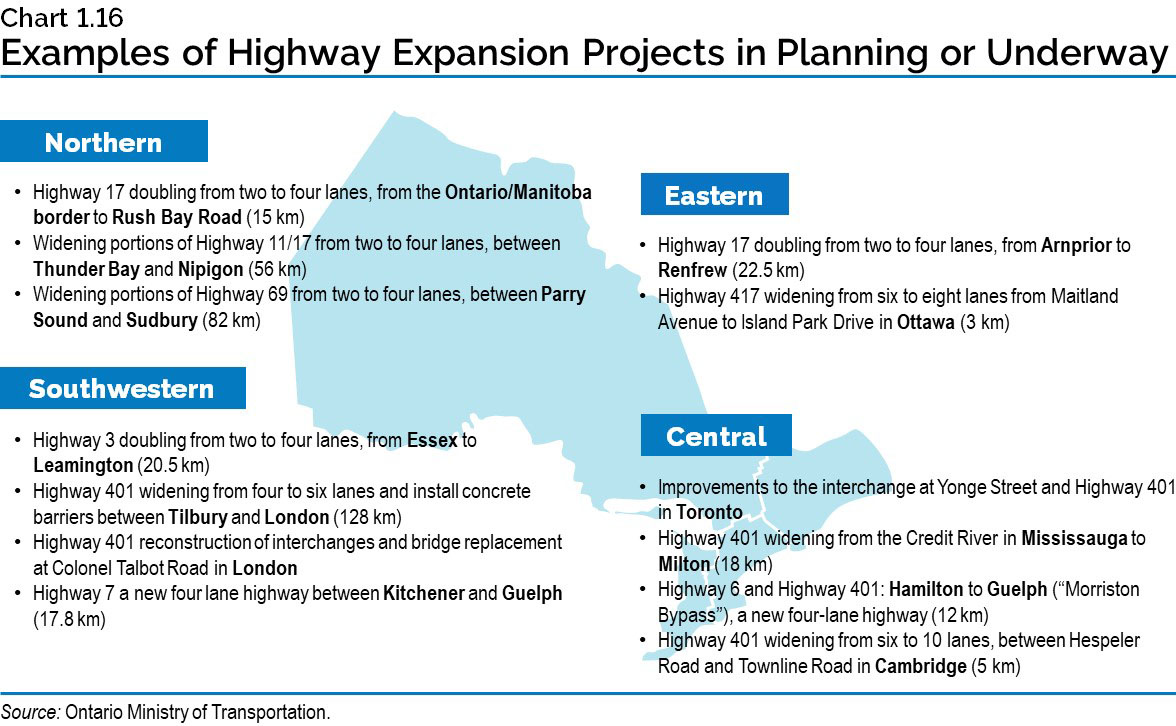
Ontario Place Development
Ontario offers the world in one province, and Ontario Place should reflect the province’s diversity, culture and pride of people and place. The government is transforming Ontario Place into a world class, year-round destination that will attract local, provincial and international visitors — and could include exciting sport and entertainment landmarks, public spaces and parks, recreational facilities and retail.
Through the ongoing Call for Development process, the government received submissions from around the world to help achieve this vision and bring the site back to life. The development of Ontario Place will encourage investment while ensuring that this unique site on Toronto’s waterfront will once again become the crown jewel of the province.
Building Universities and Colleges
Ensuring a modern and sustainable environment for postsecondary students remains a key priority for the Province in order to support colleges and universities that have been impacted by COVID‑19. This is why the government will be making an investment in critical maintenance, repairs and upgrades of $466 million in capital grants over three years starting in 2020–21 for Ontario’s universities and colleges. This investment will allow institutions to modernize classrooms, upgrade technology and improve their environmental sustainability, while continuing to deliver a safe experience for students that were welcomed back to campus this fall.
Providing high-quality postsecondary education that is accountable, accessible and affordable is important in order to meet the current and future needs of Ontario’s labour market. To address these needs, the Province moved forward to update the Major Capacity Expansion Policy Framework to encourage the responsible expansion of new postsecondary campuses. This updated framework will ensure that future campus expansions align with government priorities, including lower costs to taxpayers, meeting local labour market needs, and are in line with regional economic, community support and industry partnerships.
As a first step under this updated framework, the government announced support in July 2020 for York University’s Markham Centre Campus. This new campus, which is expected to open in fall 2023, will provide students with access to high-quality education and with on-the-job learning opportunities to prepare them for the jobs of the future. In addition, the Markham Campus is also projected to generate over $350 million in economic benefits and create an additional 2,000 jobs in the community.
Implementing the Investing in Canada Infrastructure Program
The Investing in Canada Infrastructure Program (ICIP) is a 10-year program that provides up to $30 billion in total funding, including $10.2 billion in provincial funding across the program’s four streams: Rural and Northern Communities Infrastructure; Green Infrastructure; Community, Culture and Recreation Infrastructure, and Public Transit. More recently, the federal government announced a new temporary COVID‑19 Resilience stream.
To date, the Province has nominated over 760 projects to the federal government under these four streams. The Ontario government is encouraging the federal government to move quickly to approve projects, in order to support people and their communities. Further delays in approving projects are preventing the people of Ontario from benefiting from much needed investments that are intended to create jobs and provide valuable infrastructure to communities.
Ontario is committed to working with the federal government to rebuild the economy and build healthy and safe communities across Ontario through federal–provincial programs like the Investing in Canada Infrastructure Program (ICIP). The Province will continue to work closely with the federal government and municipal governments to support strategic investments to support jobs and economic growth.
COVID‑19 Resilience Stream
In August 2020, the federal government announced a new temporary COVID‑19 Resilience stream as part of ICIP. Provinces and territories have the option to transfer up to 10 per cent of their initial allocation under the Investing in Canada Infrastructure Program towards the COVID‑19 Resilience stream to benefit from up to an 80 per cent federal cost share or 100 per cent federal cost share for Indigenous projects. This new stream will provide Ontario with the ability to support additional infrastructure priorities across the province.
The Province is partnering with the federal government to provide over $1 billion in funding to support health and safety through the accelerated delivery of priority municipal infrastructure projects as well as investments to retrofit schools and long-term care homes. Projects under this new stream will accelerate economic recovery by creating more jobs, providing more opportunities for local businesses, and improving the quality of life in these communities in response to COVID‑19. The Province will work with the federal government to support municipalities, First Nations, as well as school boards and long-term care homes to get projects underway as soon as possible.
Rural and Northern Communities Infrastructure Stream
Under the Rural and Northern Communities Infrastructure stream of the ICIP, the Ontario government is supporting the development and renewal of critical infrastructure in rural, Northern and remote communities. Application intake for this stream closed on May 14, 2019 and to date, 143 projects have been approved by the federal government. Through this stream, approximately $500 million in total funding will be unlocked to support investments in road, bridge, air and marine infrastructure projects nominated to the federal government by Ontario. These investments will create jobs and help create economic opportunities for rural and Northern communities in Ontario.
Green Infrastructure Stream
The Green Infrastructure stream of the ICIP supports the reduction of greenhouse gas emissions, enables the development of more resilient infrastructure, and ensures communities can provide clean air and safe drinking water for the people of Ontario.
The first application intake of the Green Infrastructure stream launched on October 28, 2019 and closed on January 22, 2020. Through this intake, approximately $200 million provincial and federal funding was allocated for communities with populations under 100,000, including municipalities, First Nations and other partners. This intake focused on critical health and safety projects to improve water, wastewater and stormwater infrastructure while driving economic growth in communities across the province. Ontario has nominated 76 projects to the federal government and continues to work with the federal government to finalize approvals.
Community, Culture and Recreation Infrastructure Stream
Ontario launched the Community, Culture and Recreation Infrastructure stream of ICIP on September 3, 2019, and the application intake closed on November 12, 2019. This program elicited significant demand. The federal government is currently reviewing funding applications for projects under this stream, which could unlock up to $1 billion in total funding for priority projects across the province. Investments will be allocated to community, culture and recreational projects such as community centres and cultural and recreational facilities, which is intended to deliver vital services for communities and improve the quality of life for the people of Ontario.
Public Transit Stream
Strategic investments in sustainable public transit and active transportation, as well as road and bridge infrastructure, are examples of the government taking decisive action to support families, businesses and communities. The Province continues to implement the Public Transit stream of ICIP, which will unlock $20.8 billion to support transit priorities in municipalities across the province.
Ontario is investing $7.3 billion in public transit infrastructure across the province, over 10 years, through the ICIP. The Province has nominated 270 transit projects to the federal government from 62 municipalities, which represents approximately $1.1 billion in provincial contributions.
The Province has formally nominated the four priority subway projects to the federal government — the Ontario Line, the three-stop Scarborough Subway Extension, the Yonge North Subway Extension and the predominantly underground Eglinton Crosstown West Extension — in the City of Toronto and York Region. Additionally, the Province has nominated the Bloor-Yonge Station Capacity Improvement Project and the SmartTrack Stations Program. The Province and its municipal partners are calling on the federal government to formally commit to Ontario’s four priority subway projects. Ontario is seeking at least 40 per cent of the total cost of the $28.5 billion for the four priority subway projects.
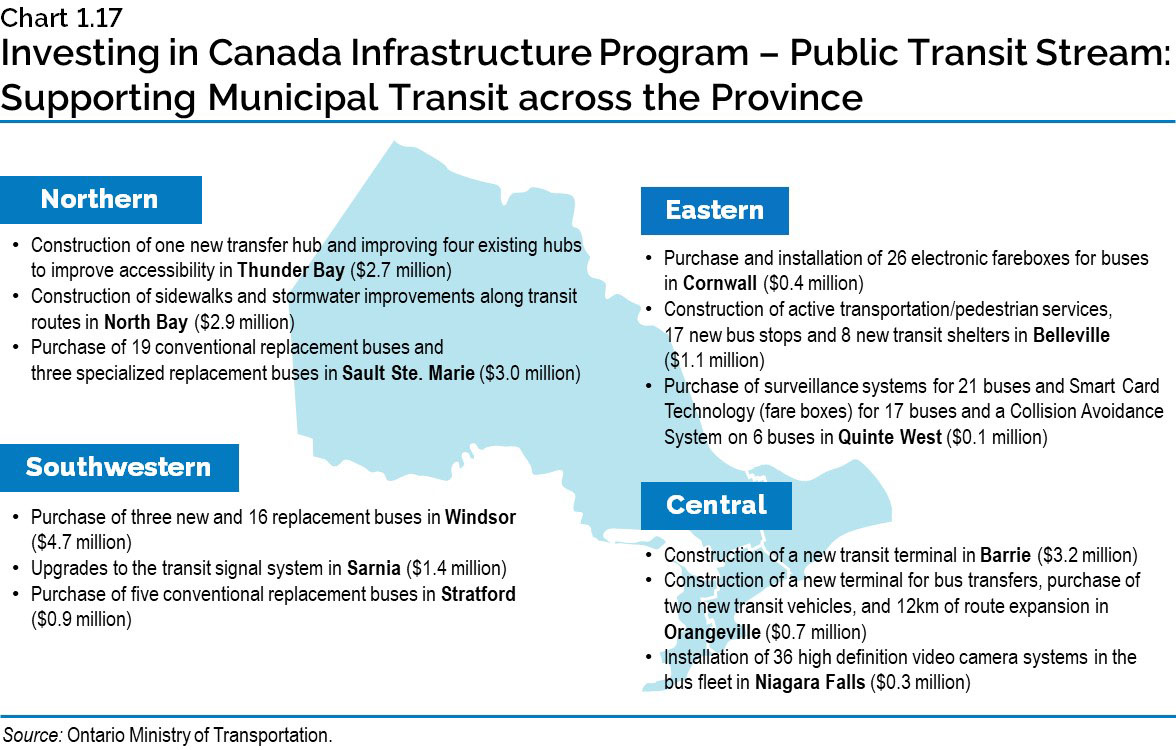
Investing in the Lou Fruitman Reena Residence
The COVID‑19 pandemic has presented the people of Ontario with unforeseen economic challenges and safety concerns. While COVID‑19 has had impacts on everyone, vulnerable populations are especially at risk. As part of addressing these needs, the government is contributing over $3 million in 2020–21 to the construction of the Lou Fruitman Reena Residence in York Region.
The Lou Fruitman Reena Residence will deliver services and provide housing for individuals with developmental disabilities and other vulnerable persons. The provincial investment will go towards accessibility enhancements for 30 units and programming space for employment services and wellness programs.
With the capital investment, Ontario is leveraging existing commitments from federal and municipal governments as well as private donors, to ensure that the project can deliver its valuable services and promote the health and economic well-being of the people of Ontario.
Modernizing Government
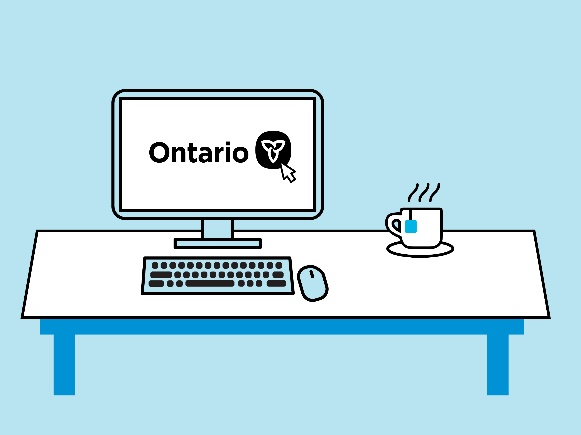
The world has changed, and government must change with it. This is why making Ontario’s programs and frontline services more convenient, reliable and accessible is vital. This transformation will help support economic growth in the province.
Since the onset of the COVID‑19 pandemic, the government has moved even more quickly to adapt and update programs and services that the people of Ontario rely on. There is still more to do. In October, the Province released Ontario Onwards: Ontario’s COVID‑19 Action Plan for a People-Focused Government, a plan to make government more effective for the people of Ontario.
Moving Ontario Onwards
Through Ontario Onwards, the government will help make the lives of people and businesses simpler. The government is committed to making Ontario the leading digital jurisdiction in the world. To get there, the government has set ambitious targets. In the next two years:
- 70 per cent of the services the people of Ontario use most, like enhanced virtual health care and business permit approvals, will be available digitally;
- 50 per cent of the most common ways the people of Ontario interact with government, like renewing their driver’s licences, will be digital; and
- 75 per cent of citizens and businesses will be satisfied with Ontario’s digital services, as measured through customer experience surveys.
But digital first does not mean digital only. Physical ServiceOntario locations will continue to offer the same services and supports, so that people who want to use them can do so. But this is just the start of the journey.
Four Pillars of the Ontario Onwards Action Plan
- Making government services more digitally accessible and making Ontario a leading digital jurisdiction worldwide by implementing initiatives like Digital Identity. When fully implemented, a digital identity will enable easier access to services across all levels of government, as well as in the private sector. A senior could confirm a doctor’s appointment online or better enable a caregiver to access records and help manage their care. A parent could more easily access their children’s immunization records and a small business owner will be able to seamlessly apply for permits and licences and cut through red tape. Digital identity could help streamline requirements and remove government burden by enabling the sharing of necessary information with each area and level of government.
- Reducing red tape and simplifying policies to make life easier for the people and businesses of Ontario while ensuring appropriate protections are in place. Initiatives such as reducing barriers for development and construction approvals and untangling Ontario’s permitting requirements will save businesses money while letting them spend less time on unnecessary paperwork. The government is also committed to coordinating inspectors’ visits to factories and worksites in the most efficient manner possible, instead of subjecting businesses to multiple, uncoordinated days of inspections that slow productivity.
- Improving government purchasing by leveraging the combined bulk-buying power of the province, while taking advantage of world-class capabilities of local Ontario businesses. Challenges sourcing critical supplies and equipment, including personal protective equipment (PPE), during the COVID‑19 pandemic reinforced the need to improve the current approach. Centralizing procurement will accelerate the work to transform and modernize how the government purchases goods and services so the people of Ontario can have the supplies they need when they need them.
- Creating more responsive and flexible public services so citizens can get what they need faster and easier. The COVID‑19 pandemic reinforced the need for the Ontario Public Service and the Broader Public Sector to revisit how they serve the people of the province. Government processes will be made more efficient, including redesigning complicated, confusing forms and applying the principles of Lean to ensure that work on the front lines, and behind the scenes, brings value to the people of Ontario. Core processes, such as approvals for program or permit applications, will be redesigned so citizens can get what they need faster and easier. The government will also work to expand the collection of provincial public-sector workforce data to increase transparency and accountability and make more effective use of public resources.
The new Ontario Onwards Acceleration Fund will help with the implementation of projects that will make a difference in how people and businesses experience services in Ontario. It will support the scale-up of new and innovative ideas that will lay the groundwork for longer-term change. The Fund will encourage and accelerate transformation across government by supporting innovative ideas and providing opportunities to pilot new technologies. By focusing on outcomes and user needs, it will ensure public funds are directed to projects and programs that matter to people and businesses.
This investment will bring a sharper focus to efforts that are able to demonstrate measurable, evidence-based results for continuous improvement in government. This reinforces the government’s commitment to put the people at the center of everything it does.
The moving Ontario’s justice system forward, Supply Ontario and the ServiceOntario customer experience enhancements initiatives highlighted below are three examples of key Ontario Onwards Action Plan initiatives.
Moving Ontario’s Justice System Forward
The government is building a more accessible, responsive and resilient justice system by establishing new and innovative ways of delivering services in person and online. From the onset of the COVID‑19 pandemic, the Ministry of the Attorney General has been working with its justice sector partners to move Ontario’s justice system forward through innovation, transformational technology investments, and modernizing court processes and procedures. This includes supporting new ways of conducting court proceedings virtually and adopting online methods for interacting with the justice system to reduce the need for visiting courthouses. These changes will make it easier, faster and more affordable for the people of Ontario to access the justice system no matter where they live.
The government is rethinking how it invests taxpayers’ money in courthouses to ensure the justice system is accessible, responsive and operating in a way the people of Ontario would expect in the 21st century. Investing in new technology, reimagining how courthouse space is used and adopting best practices from leading jurisdictions around the world will provide the people of Ontario with a modern experience when they need to interact with the justice system.
The demands on the justice sector throughout COVID‑19 have highlighted that Ontario requires a more accessible, responsive and resilient justice system in order to deliver services remotely, in person and online. The government agrees with its justice sector partners that the sector cannot go back to the old way of doing things and is committed to continuing to move Ontario’s justice system forward.
Establishing Supply Ontario to Secure Critical Supplies
The COVID‑19 pandemic revealed challenges in securing critical supplies and equipment such as personal protective equipment (PPE) to safeguard the people of Ontario, including frontline workers and vulnerable persons. Since the onset of the pandemic, Ontario has been procuring these supplies and equipment through its traditional suppliers as well as working directly with manufacturers, including Ontario-based vendors that were able to retool and respond to Ontario’s call to action. Building on this critical need, Ontario is establishing Supply Ontario, a centralized supply chain agency to:
- Stabilize access to a high-quality supply of critical products;
- Deliver the best value by sourcing high-quality goods at scale to serve the public interest in a financially responsible way;
- Stimulate job creation and economic growth by producing Ontario-made goods; and
- Drive innovation of emerging technologies connecting small businesses and entrepreneurs to government and its customers.
Enhancing the ServiceOntario Customer Experience
ServiceOntario is vitally important as the frontline face of customer service for millions of people in Ontario. The government is taking action to improve digital services and keep in-person services safe during the COVID‑19 pandemic and beyond.
Improvements to ServiceOntario’s digital platform have resulted in increased capacity to fulfill online transactions, and 30 per cent faster processing times on high volume transactions such as licence plate sticker renewals. This makes it easier for the people of Ontario to take advantage of over 40 services available online 24/7.
Digital first does not mean digital only. The government has also provided stipends and communications materials to support the protection of customers and staff and are also introducing appointment booking at some locations.
The government continues to prioritize the development of ServiceOntario’s Retail Strategy.
Consulting on Unregulated Tobacco
Following through on the government’s 2019 commitment to consult stakeholders on unregulated tobacco, the Ontario Ministry of Finance continues to engage health advocates, tobacco industry participants and retail and business associations.
In addition to increased enforcement, stakeholders are suggesting further collaboration with federal partners, and working with First Nations towards mutually beneficial arrangements to regulate tobacco.
First Nations perspectives and interests in tobacco must be considered in developing solutions to the problem of unregulated tobacco. The Province will engage First Nations on this important subject.
Establishing a Market for Internet Gaming (iGaming) in Ontario
In the 2019 Budget, the government stated its intention to establish an online market for internet gaming (iGaming) in Ontario that is both competitive and protects consumers. In continuing to work towards this goal, the Province is introducing legislation to give the Alcohol and Gaming Commission of Ontario (AGCO) authority to conduct and manage iGaming, in addition to having the role of the regulator.
If the proposed legislation is passed, a dedicated subsidiary under the AGCO would be established as the conduct and manage entity to manage the relationship between the government and private iGaming operators.
The Province and the AGCO intend to continue consulting with key stakeholders on the design of the iGaming market to reflect consumer preferences and foster an exciting gaming experience, while ensuring that appropriate responsible gaming protections are in place. These engagements will include a number of diverse topics, including approaches for revenue collection, data and gaming system requirements, the licensing and registration approach, product offerings and marketing considerations.
The Province will also continue to engage with the federal government to encourage the legalization of single-event sports wagering. Legal single-event sports wagering would help support the growth of a competitive online gambling market in the province and, as a popular form of wagering, would also benefit other parts of the gaming sector.
Creating Opportunities through the Value Creation Task Force
As announced in the 2019 Ontario Economic Outlook and Fiscal Review, the government established a Value Creation Task Force to identify and review innovative opportunities to generate recurring non‐tax revenues. These revenues can be reinvested back into critical government services like health care, education, roads and transit.
The Task Force is continuing its work with multiple ministries in identifying, assessing and pursuing potential opportunities for value creation across government to generate additional incremental revenues for Ontario. For example, the Ministry of Transportation (MTO) is putting in place a value creation framework and is exploring opportunities such as leveraging assets owned by MTO or Metrolinx.
Supporting Sustainable Collective Bargaining Outcomes in the Public Sector
In November 2019, the Legislature passed the Protecting a Sustainable Public Sector for Future Generations Act, 2019. The Act enables the government to manage compensation growth in a way that allows for reasonable wage increases while also respecting taxpayers and the services they rely on. This effort has helped the government and public-sector employers reach wage outcomes that are sustainable, while ensuring that public-sector jobs and vital frontline services are protected.
Since the Act’s introduction, collective agreements covering over 340,000 unionized public-sector employees have been settled in compliance with the Act. This represents over 40 per cent of unionized employees in Ontario’s broader public sector (BPS). Additionally, settlements reached in the private sector over this same period included average annual wage increases of 2.2 per cent — roughly double those reached in Ontario’s public sector.
The government is proposing amendments to the Protecting a Sustainable Public Sector for Future Generations Act, 2019 to ensure a fair and consistent application of the Act. These amendments clarify the application for in-scope employees who change bargaining status and add enforcement tools to support compliance with the Act.
Since fall 2018, the government has successfully overseen collective bargaining across its provincial agencies. Through this process, the Province has been able to direct agencies and their respective bargaining agents to reach negotiated settlements that promote labour stability and achieve wage outcomes that are consistent with the government’s broader approach to managing compensation. To date, legislative and oversight measures have allowed the government to successfully support agencies in reaching negotiated settlements that have driven cost avoidances totalling $21 million by 2024–25.
Looking ahead, the government will continue to explore expanding its oversight over collective bargaining to other key areas of the BPS. In conjunction with these efforts, the government will also explore more regular and robust reporting on workforce and compensation data from its service delivery partners. Delivered through user-friendly digital reporting tools and using existing channels where possible, improved reporting would provide the government the information it needs to make decisions that impact the public-sector workforce and ultimately outcomes for the people of Ontario. As always, the government is committed to working closely with all public-sector employers, employees and bargaining agents as part of this process.
Supporting the Sustainability and Affordability of Public-Sector Pension Plans
Like private pension plans, public-sector pension plans face challenges from low interest rates, investment volatility, longevity improvements and membership maturation. The consolidation of smaller pension plans with larger pension plans is one strategy that supports the sustainability and affordability of public-sector pension plans and can be used to help address the challenges facing these plans.
The government has recently supported the designation of several new agencies and the consolidation of two smaller agency pension plans into the Public Service Pension Plan. These efficiencies are estimated to save the government approximately $19 million by the end of 2020, with ongoing savings expected.
Designations and consolidations bring several other benefits including back-office efficiencies, reduction in agency resources associated with pension administration, consolidated and cost‑effective asset-management through the Investment Management Corporation of Ontario, and superior service delivery for employers and members. The scale and resulting efficiencies save taxpayers money over the long term.
In keeping with the commitment to pension efficiencies, amendments to the Financial Administration Act are being proposed. If passed, these amendments would allow for certain pension plans to be managed in a manner that is more affordable for the government.
Footnotes
[1]Estimated total municipal and provincial relief reflects assumptions about potential rate of municipal uptake of the small business property subclass, the extent of the rate reduction applied to the subclass, and provincial matching of the municipal relief.
[2]Kahn, Matthew E., and Erin T. Mansur, 2013. “Do Local Energy Prices and Regulation Affect the Geographic Concentration of Employment?”, Deschenes, Olivier, 2012. “Climate Policy and Labor Markets.”
[3]Statistics Canada, 2016 Census.
[4]Between February and May 2020, employment declined by 17.2 per cent for females and 13.6 per cent for males. Source: Statistics Canada.
Chart Descriptions
Chart 1.6: Electricity Prices for Commercial and Industrial Employers
This bar graph shows the increase of electricity prices for commercial and industrial employers in Ontario between 2008 and 2019. Between 2008 and 2019 the electricity prices for medium-size and larger commercial customers increased from 5.8 ¢/kWh to 12.6 ¢/kWh. Electricity prices for large industrial consumers increased from 5.5 ¢/kWh in 2008 to 7.6 ¢/kWh in 2019.
| Year | Commercial | Industrial |
|---|---|---|
| 2008 | 5.8 | 5.5 |
| 2019 | 12.6 | 7.6 |
1. Prices shown do not include other components of the electricity bill, such as delivery, regulatory or Debt Retirement Charge (DRC was ended as of March 31, 2018), which have generally been more stable than electricity commodity costs of generation. Large electricity consumers generally pay lower per-unit delivery charges than mid-size consumers.
2. The commodity cost is comprised of the Hourly Ontario Electricity Price (HOEP) and the Global Adjustment (GA) charge. The average Class A consumer is assumed to pay a lower average HOEP than the average Class B consumer due to their demand profile. GA charges for the average Class A consumer (such as large industrials) are lower than Class B customers (e.g., medium size commercial customers), reflecting Class A customers shifting demand from the peak periods during the year, helping to lower system costs, and lowering their share of GA costs under the Industrial Conservation Initiative (ICI). ICI took effect in 2011.
Source: Ontario Ministry of Energy, Northern Development and MinesChart
Chart 1.7: Lowering Electricity Bills – Illustrative Industrial Employer
Two sample bills illustrate the savings produced by the government’s comprehensive electricity plan to provide electricity cost relief versus the status quo for an Industrial Consumer (Class A). The sample electricity bill for January 2021 with cost relief as compared to the status quo January 2021 bill indicates electricity commodity savings from a lower Global Adjustment cost of about $31,800 per month or nearly $382,000 annually for an illustrative example of an industrial company with electricity consumption of 2,340,400 kilowatt-hours.
Note: Class A consumers are larger electricity consumers and are participants in the Industrial Conservation Initiative. The benefit varies depending on consumption and responsiveness to peak demand. Consumers paying higher Global Adjustment (GA) would receive a larger benefit compared to consumers paying lower GA. Industrial consumers would also save on transmission charges reflecting lower line loss costs. Net savings are from reduced electricity charges, excluding reductions in Harmonized Sales Tax (HST) paid on the bill. Businesses are able to offset HST costs with input tax credits, so a change in HST results in no net change in electricity costs.
Status quo commodity cost is based on actual Hourly Ontario Energy Price (HOEP) and average GA for 2019, escalated by two per cent per year. The industrial consumer is assumed to be 5 MW and transmission-connected with rates effective January 1, 2020, escalated by two per cent per year. The impact of the proposal on GA is based on the share of GA costs effectively July 1, 2020 and year to date August 2020 share of demand. Hydro One’s transformer loss allowance factor is applied. The Northern Industrial Electricity Rate Program would reduce prices for eligible northern industrials by an additional 2 cents per kilowatt-hour (¢/kWh)
Source: Ontario Ministry of Energy, Northern Development and Mines
Chart 1.8: Lowering Electricity Bills – Illustrative Commercial Employer
Two sample bills illustrate the savings produced by the government’s comprehensive electricity plan to provide electricity cost relief versus the status quo for a Commercial Consumer (Class B). The sample electricity bill for with cost relief in January 2021 as compared to status quo sample electricity bill in January 2021 indicates electricity commodity savings from a lower Global Adjustment cost of about $10,900 per month or over $130,000 annually for an illustrative example of a commercial company with electricity consumption of 403,200 kilowatt-hours.
Note: Class B consumers for the illustrative example are medium size or larger consumers that are too large for the Regulated Price Plan (RPP) and are not eligible for the lndustrial Conservation Initiative (ICI) for larger businesses. The benefit varies depending on consumption and responsiveness to peak demand. Consumers paying higher Global Adjustment (GA) would receive a larger benefit compared to consumers paying lower GA. Commercial consumers would also save on delivery charges reflecting lower line loss costs. This benefit would apply to non-RPP Class B consumers. Net savings are from reduced electricity charges, excluding reductions in HST paid on the bill. Businesses are able to offset HST costs with input tax credits, so a change in HST results in no net change in electricity costs.
Status quo commodity cost is based on the Ontario Energy Board’s November 2020 forecast, escalated by two per cent per year. The commercial consumer is assumed to be 1 MW and connected to Alectra (Enersource) with rates effective January 1, 2020, escalated by two per cent per year and includes line losses. The impact of the proposal on the GA is based on the share of GA costs effective July 1, 2020 and year to date August 2020 share of demand.
Source: Ontario Ministry of Energy, Northern Development and Mines
Chart 1.9: Providing Electricity Cost Savings for Industrial and Commercial Employers
This bar chart illustrates the savings produced by the new electricity cost relief versus status quo for select industrial sectors and average industrial and commercial Consumers (Class A and Class B). For example, iron and steel manufacturing and auto manufacturing sectors would save an average of 11 and 16 per cent in electricity costs, respectively, due to the reform.
| Manufacturer Type | Savings Percentage |
|---|---|
| Iron & Steel | 11% |
| Metal Ore Mining | 14% |
| Auto Manufacturing | 16% |
| Chemical Manufacturing | 16% |
| Pulp & Paper | 8% |
| Average Class A | 14% |
| Average Class B1 | 16% |
1. This benefit would apply to non-RPP Class B consumers
Sources: Ontario Ministry of Energy, Northern Development and Mines; Independent Electricity System Operator; Ontario Energy Board.Chart 1.10: Improving Competitiveness: Average Electricity Pricing for Commercial and Industrial Employers
Two tables for commercial and industrial consumers compare average electricity pricing for some sample state jurisdictions across the Unites States and Ontario. These indicate that Ontario’s new electricity relief will decrease electricity prices from 17.02 ¢/kWh to 14.31 ¢/kWh, on average, for commercial customers in Ontario, which compares favourably to the average price across the United States of 14.38¢/kWh for commercial customers. For industrial electricity customers in Ontario, Ontario’s new electricity relief will decrease electricity prices from 9.42 ¢/kWh to 8.05 ¢/kWh, on average, which compares favourably to the average price across the United States of 9.00¢/kWh for industrial customers. Note that these are all in Canadian cents per kilowatt-hour.
| Jurisdiction | Cost (Canadian ¢/kWh) |
|---|---|
| Pennsylvania | 11.65 |
| Illinois | 12.18 |
| Ohio | 12.66 |
| Minnesota | 14.31 |
| Ontario (New) | 14.31 |
| U.S. Average | 14.38 |
| Indiana | 14.76 |
| Wisconsin | 15.03 |
| Michigan | 15.91 |
| New Jersey | 16.98 |
| Ontario (Status Quo) | 17.02 |
| New York | 19.19 |
| Jurisdiction | Cost (Canadian ¢/kWh) |
|---|---|
| New York | 7.36 |
| Ohio | 7.82 |
| Ontario (New) | 8.05 |
| Pennsylvania | 8.42 |
| Illinois | 8.76 |
| U.S. Average | 9.00 |
| Indiana | 9.29 |
| Ontario (Status Quo) | 9.42 |
| Michigan | 10.30 |
| Wisconsin | 10.48 |
| Minnesota | 10.86 |
| New Jersey | 13.77 |
Notes: Prices for U.S. jurisdictions reflect July 2020 data from the U.S. Energy Information Administration's survey of approximately 500 of the largest electric utilities. The price reflects the average revenue reported by the electric utility from electricity sold to the commercial sector. The value represents an estimated average retail price but does not necessarily reflect the price charged to an individual consumer. Prices are converted at an exchange rate of 1 USD = 1.363 CAD, as the average exchange rate from January to July 2020.
The prices for Ontario reflect forecasted average industrial and indicative commercial prices in 2021. The effective all-in rate would vary depending on consumption and location. The commodity portion is based on a forecast of Hourly Ontario Energy Price (HOEP) and Global Adjustment (GA) under the status quo and a scenario where a portion of non-hydro renewable generation costs are funded by the Province. The delivery and regulatory portion of the illustrative example of industrial and commercial prices reflect the Hydro One uniform transmission rates and the Alectra distribution rate in the Enersource rate zone, respectively effective January 1, 2020, and are assumed to increase by two per cent. The illustrative industrial consumer is assumed to be a 5 MW consumer with a 65 per cent load factor, while the illustrative commercial consumer is assumed to be a 499 kW consumer with a 56 per cent load factor. Line losses are included; HST is excluded. The Northern Industrial Electricity Rate Program would reduce prices for eligible Northern industrials by an additional 2 cents per kilowatt-hour (¢/kWh).
Source: Ontario Ministry of Energy, Northern Development and Mines.
Chart 1.11: Costs Shifted to the Province are Forecast to Decline under the Government’s Plan
The stacked bar graph shows that the estimated costs of the solar, wind and bioenergy contracts over the period 2020 to 2040 steadily declines over time. The fiscal impact of the Province directly funding a portion of high-cost wind, solar and bioenergy contracts costs is expected to decline year over year as the cost of the 20-year renewable contracts signed starting in the mid-2000s begins to decline as the contracts expire. By about 2040, no further government funding would be required to subsidize the cost of these contracts. The chart shows contract costs by estimated components in a stacked bar chart, with estimated market revenue, capacity value of non-hydro renewables and the contracted cost forecast to be shifted to the Province.
Notes: The market revenue represents the revenue received in the IESO-run market at the market clearing price. The capacity value of renewable generation left with IESO was determined by assigning to the generating capacity that IESO forecasts to be available at summer and winter peak based on the cost of new generating resource, which is assumed to be $128,000/MW-year. IESO assesses effective capacity at summer and winter peak from contracted renewable generation as per its modelling.
Source: Ontario Ministry of Energy, Northern Development and Mines
Chart 1.12: Illustrative Savings for a Commercial Property in London
Illustrative Savings for a Commercial Property
This chart uses an example of a London Hotel valued at $12 million and illustrates the benefit of the proposed Business Education Tax (BET) rate reduction, the electricity relief and the resulting savings.
Before the proposed reduction, the BET for the example hotel is calculated by multiplying the assessment of $12 million by London’s 2020 BET rate of 1.25 per cent, which equals $150,000. After the proposed reduction, the BET on the hotel is calculated by multiplying the assessment of $12 million by London’s proposed 2021 BET rate of 0.88 per cent, which equals $105,600. The savings resulting from the proposed BET rate reduction is $44,400. In addition, the electricity relief will bring an estimated $11,500 in annual savings, resulting in a total savings of $55,900 for the business.
Notes: While the example does not represent an actual business property, the assessed property value is based on a sample of assessed values for businesses in the City of London. The calculation of electricity savings are based on an illustrative example of a hotel with a monthly average maximum peak demand of 87kW and use of 440,000 kWh per year and assumes that the hotel is not currently receiving other existing electricity cost relief programs.
Chart 1.13: Illustrative Savings for an Industrial Property in Windsor
Illustrative Savings for an Industrial Property
This chart uses an example of a manufacturing facility in Windsor valued at $10 million and illustrates the benefit of the proposed Business Education Tax (BET) rate reduction, the electricity relief and the resulting savings.
Before the proposed reduction, the BET on the example manufacturing facility is calculated by multiplying the assessment of $10 million by Windsor’s 2020 BET rate of 1.25 per cent, which equals $125,000. After the proposed reduction, the BET on the manufacturing facility is calculated by multiplying the assessment of $10 million by Windsor’s proposed 2021 BET rate of 0.88 per cent, which equals $88,000. The savings resulting from the proposed BET rate reduction is $37,000. In addition, the electricity relief will bring $57,500 in annual savings, resulting in a total savings of $94,500 for the business.
Notes: While the example does not represent an actual industrial property, the assessed property value is based on a sample of assessed values for industrial businesses in the City of Windsor. Calculation of electricity savings are based on an illustrative example of an industrial facility with a monthly average maximum peak demand of 375 kW and annual consumption of 2.2 million kWh.
Chart 1.14: Illustrative Property Tax Savings for a Bakery Shop in Toronto
This chart illustrates the potential property tax savings for a small business property resulting from the proposed reduction in the Business Education Tax (BET) rate and the proposed property tax relief for small businesses.
The chart uses an example of a bakery shop, a small business property in Toronto, that is assessed at $1.5 million. The chart shows the breakdown of property tax savings resulting from the measures introduced in the 2020 Budget. This includes $1,500 from the proposed reduction in the Business Education Tax rate and potential savings from the proposed property tax relief for small businesses, assuming the City of Toronto adopts the proposed small business property subclass. The adoption of the subclass would result in a $4,000 reduction in Business Education Taxes and $5,000 reduction in municipal property taxes. Taken together, these measures would total $10,500 in property tax savings.
Chart 1.15: Illustrative Tax Relief Before and After the Increase to the Employer Health Tax Exemption from $490,000 to $1 Million
This chart shows two illustrative examples of tax relief provided by increasing the EHT payroll exemption from $490,000 (before) to $1 million (after).
Left example: (Before) A restaurant owner would have owed $4,095 in EHT on $700,000 of payroll with an exemption of $490,000. (After) Doubling the exemption to $1 million means that this employer pays no EHT in 2020 and would continue to pay no EHT in 2021 on payroll of $700,000 (i.e., EHT would be reduced by $4,095 to zero, which represents a 100 per cent tax cut in each of 2020 and 2021).
Right example: (Before) An Ontario building contractor with a payroll of $1.5 million would have owed $19,695 in EHT with an exemption of $490,000. (After) Doubling the exemption to $1 million means that this employer would owe only $9,750 on $1.5 million of payroll in each of 2020 and 2021 (i.e., EHT would be reduced by $9,945, which represents an approximate 50 per cent tax cut in each of 2020 and 2021).
Chart 1.16: Examples of Highway Expansion Projects in Planning or Underway
This map of Ontario provides examples of highway expansion projects in the planning stage or are underway.
Northern:
- Highway 17 doubling from two to four lanes, from the Ontario/Manitoba border to Rush Bay Road (15 km)
- Widening portions of Highway 11/17 from two to four lanes, between Thunder Bay and Nipigon (56 km)
- Widening portions of Highway 69 from two to four lanes, between Parry Sound and Sudbury (82 km)
Eastern:
- Highway 17 doubling from two to four lanes, from Arnprior to Renfrew (22.5 km)
- Highway 417 widening from six to eight lanes from Maitland Avenue to Island Park Drive in Ottawa (3 km)
Central:
- Improvements to the interchange at Yonge Street and Highway 401 in Toronto
- Highway 401 widening from the Credit River in Mississauga to Milton (18 km)
- Highway 6 and Highway 401: Hamilton to Guelph (“Morriston Bypass”), a new four-lane highway (12 km)
- Highway 401 widening from six to 10 lanes, between Hespeler Road and Townline Road in Cambridge (5 km)
Southwestern:
- Highway 3 doubling from two to four lanes, from Essex to Leamington (20.5 km)
- Highway 401 widening from four to six lanes and install concrete barriers between Tilbury and London (128 km)
- Highway 401 reconstruction of interchanges and bridge replacement at Colonel Talbot Road in London
- Highway 7 a new four lane highway between Kitchener and Guelph (17.8 km)
Source: Ontario Ministry of Transportation.
Chart 1.17: Investing in Canada Infrastructure Program – Public Transit Stream: Supporting Municipal Transit across the Province
This map of Ontario provides examples of projects that have been approved by the federal government under the Investing in Canada Infrastructure Program.
Northern:
- Construction of one new transfer hub and improving four existing hubs to improve accessibility in Thunder Bay ($2.7 million)
- Construction of sidewalks and stormwater improvements along transit routes in North Bay ($2.9 million)
- Purchase of 19 conventional replacement buses and three specialized replacement buses in Sault Ste. Marie ($3.0 million)
Eastern:
- Purchase and installation of 26 electronic fareboxes for buses in Cornwall ($0.4 million)
- Construction of active transportation/pedestrian services, 17 new bus stops and 8 new transit shelters in Belleville ($1.1 million)
- Purchase of surveillance systems for 21 buses and Smart Card Technology (fare boxes) for 17 buses and a Collision Avoidance System on 6 buses in Quinte West ($0.1 million)
Central:
- Construction of a new transit terminal in Barrie ($3.2 million)
- Construction of a new terminal for bus transfers, purchase of two new transit vehicles, and 12km of route expansion in Orangeville ($0.7 million)
- Installation of 36 high definition video camera systems in the bus fleet in Niagara Falls ($0.3 million).
Southwestern:
- Purchase of three new and 16 replacement buses in Windsor ($4.7 million)
- Upgrades to the transit signal system in Sarnia ($1.4 million)
- Purchase of five conventional replacement buses in Stratford ($0.9 million)
Source: Ontario Ministry of Transportation.